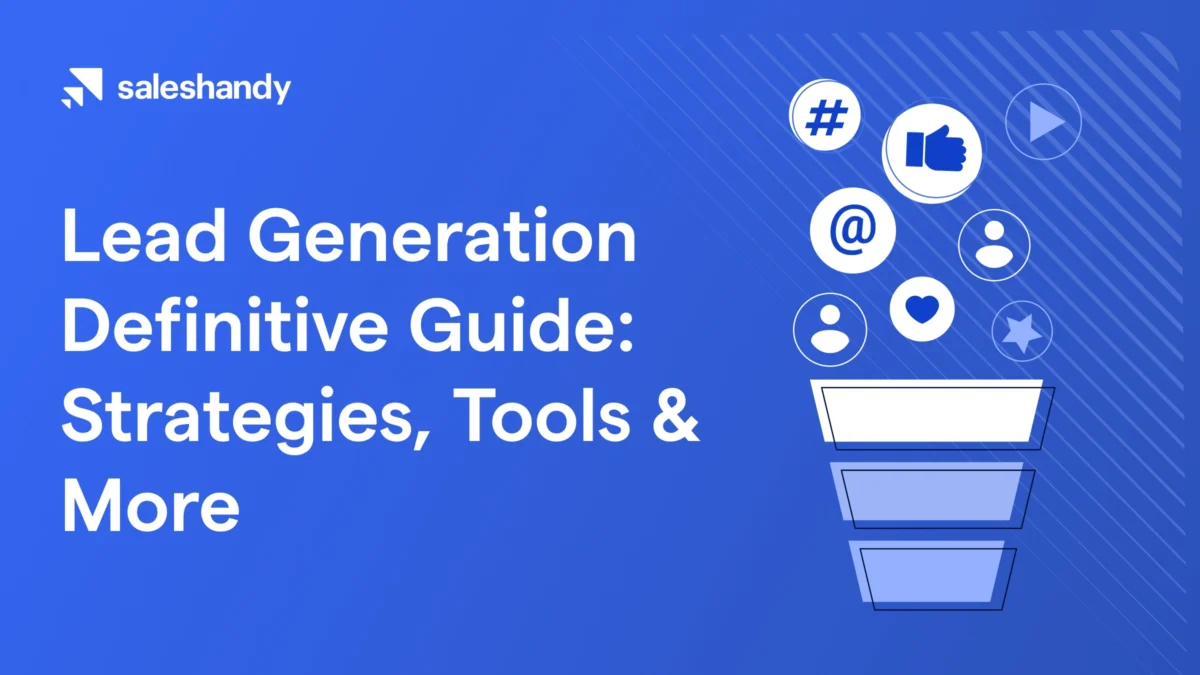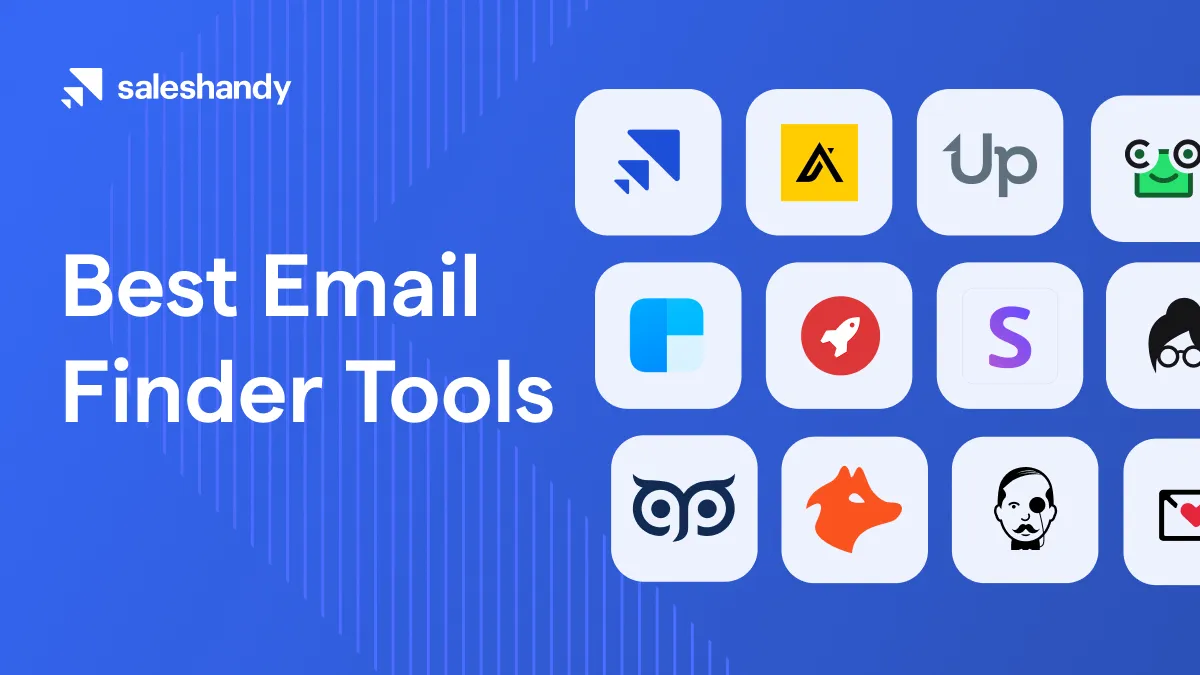Contents
- 1 What Is Lead Generation?
- 2 Why Is Lead Generation Important For Your Business?
- 3 How Does the Lead Generation Process Work?
- 4 What Are the Types of Leads?
- 5 How to Determine the Quality of a Lead?
- 6 How to Generate Leads? (Lead Generation Strategies)
- 7 How to Build a Strategic Lead Generation Plan?
- 8 How Do You Convert a Lead Into a Paying Customer? (Lead Nurturing)
- 9 What Are the Common Challenges in Lead Generation, and How Can They Be Overcome?
- 10 How Can You Measure and Optimize Your Lead Generation Efforts?
- 11 What Are Some Essential Lead Generation Tools?
- 12 Which Lead Generation Companies Should You Consider Hiring? (Based on Region)
- 13 Conclusion
Lead generation, in theory, looks like an easy process, but the ones involved will have a different story to tell.
Finding the right audience, engaging with them, nurturing and building a trustworthy relationship, and preparing them for the next stage – sales conversion.
The deeper you go, the more you learn that it involves many other processes to get prospects ready for conversion.
This definitive guide was created to educate and help solve all your lead generation problems.
Whether you’re a novice just starting your journey or an expert struggling to generate qualified leads, this guide will offer insights, strategies, and tools to help you navigate the complexities of lead generation.
From identifying your ideal audience to nurturing leads and everything in between, we’ve got you covered.
So, without delays, let’s dive in and learn how to transform your lead generation approach and achieve the growth your business deserves.
What Is Lead Generation?
Any individual that expresses an interest in your organization’s product or service is generally considered to be a ‘lead’.
The process of lead generation involves reaching out to or attracting individuals who could be potentially interested in your product or service.
Here’s an example to help.
Say you have a product that can automate and scale cold email outreach campaigns.
Ideally, you’d target and attract an audience of marketers and sales professionals who are looking to boost and scale their outreach efficiently.
To catch their attention, you can use several methods, such as sharing success stories of other clients, writing informative articles showing how you can solve their problems, etc.
This opens up communication with your prospects in the hopes of them converting into paying customers.
Why Is Lead Generation Important For Your Business?
What would your company look like if you had no lead generation strategy?
You may have to rely on sheer luck, hoping someone will buy your product or service.
Without ‘leads’, it will be extremely difficult for your business to maximize growth and revenue.
So you get it: leads are an essential component of sustainable growth.
But what is the actual importance of lead generation, and how does your organization benefit from it?
Let’s delve into why lead gen is paramount for the success of your business:
- Lead generation helps increase brand awareness and reputation. The process entails educating your leads about your company and the products and services you offer.
Whether they came to you themselves or you targeted them, either way, they learn more about your product’s features and your organization.
- When you undertake the process of lead generation, you are able to target a specific group of people who will most likely benefit from your product and are also relevant to your business.
This will result in generating high-quality leads that will increase your sales (better ROI).
- The more leads you generate, the more information you collect about your prospective customers – their pain points and preferences.
You can use this information to improve upon your product and tailor it to your prospects’ needs and wants.
- It’s a competitive market out there! If your marketers and sales folks are spending too much time chasing leads without any actual effective conversions, then it is a colossal waste of time.
Lead generation targets potential customers through a strategy specifically tailored to bring in quality leads that will benefit from your product. When efforts are invested in this, you save time and resources.
- Creating content and uploading it onto the web can get you traffic, perhaps a lot of it. But here’s the issue: If your visitors aren’t converting into leads, then your efforts are wasted.
With lead generation, your approach is highly targeted. You create content with your Ideal Customer in mind (i.e., the prospects you reach out to or attract).
By doing this, you improve the quality of your leads.
- With an effective lead gen strategy in place and all of the aforementioned benefits, your company can generate more sales and, thereby, more revenue.
When done correctly, lead generation can yield favorable results and maximize your brand’s reach.
With the right messaging, offers, and content, you can generate interest from your ideal customers.
When you focus your interests and efforts on the pain points of your audiences, you will undoubtedly achieve worthwhile results.
By now, you have a clear understanding of the importance of lead generation.
Let us now delve into how the lead generation process works. So, keep reading further!
How Does the Lead Generation Process Work?
You can easily understand how the lead generation process works by imagining it as a funnel through which your potential customers can travel.
At the top of the lead generation funnel, you are at the awareness stage. This is where you’d target and attract a large audience.
At this particular stage, you’re not worried about who’s the right fit. You try to attract all those who need a solution.
Then comes the middle of the funnel. This is where you’ll pique their interest and desire.
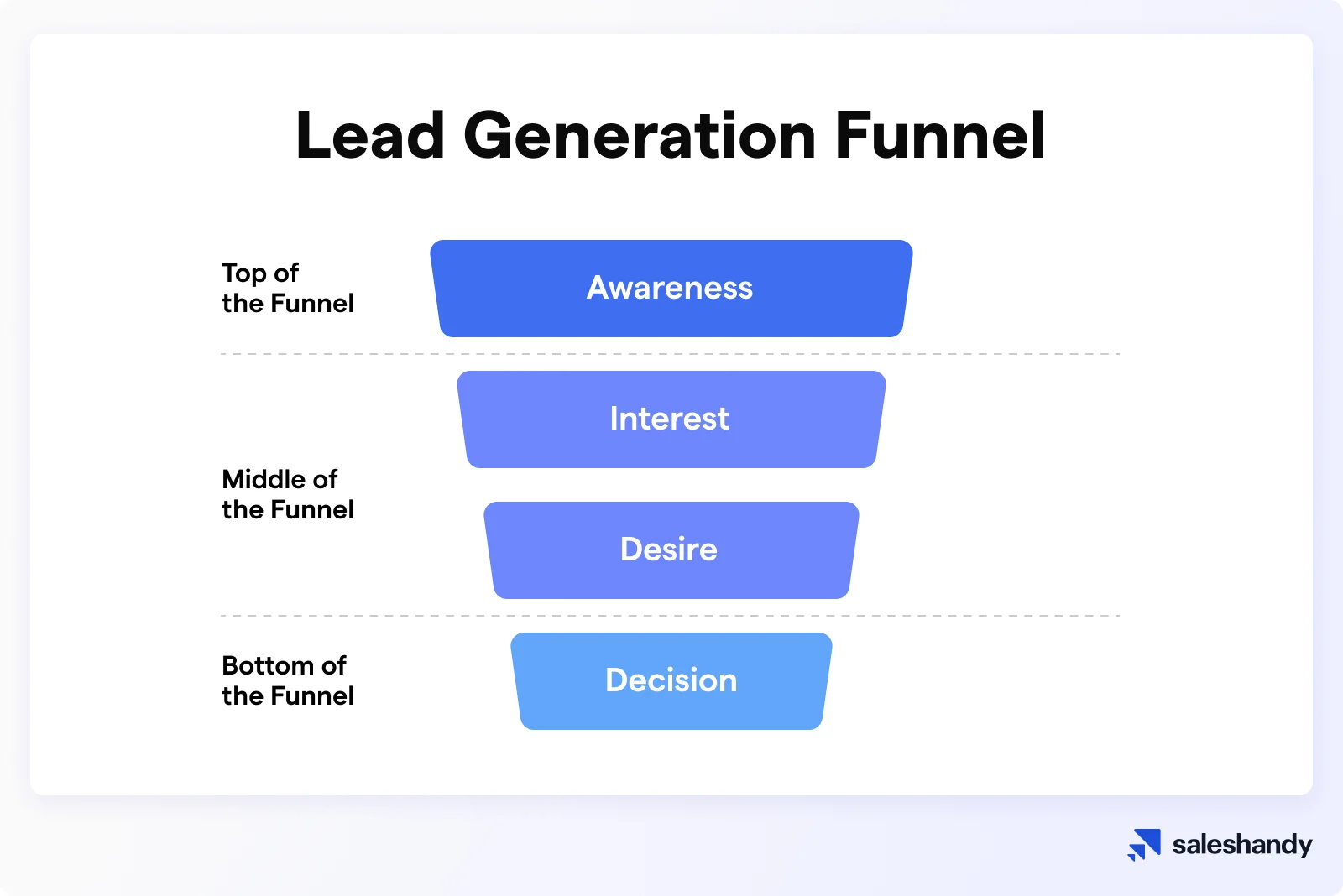
You can do this by educating your potential customers about the value of your product or service and showing them how it can solve their challenges.
As potential customers begin to get a clear picture of what you have to offer, their general interest turns into genuine consideration.
This sets the stage for you to target them with insights and solutions that resonate deeply with their unique situations.
Finally, we arrive at the last phase, the bottom of the lead generation funnel, which is also known as the decision-making phase.
At this phase, you’ll have high-intent buyers who have all the information they need and are contemplating whether to proceed with your solution.
To seal the deal, you can create tailored resources that will compel them to take action, such as a sign-up, scheduling a demo call, or giving their contact information for a freebie.
This is how you get a complete stranger to get well acquainted and interested in your offering.
Next, we’ll look at the various types of leads that you can get through lead generation. Stick with us to learn more!
What Are the Types of Leads?
You will come across a wide range of leads once you start your lead generation process.
Knowing how they are distinct from one another will help you tailor your strategies to engage each lead type effectively.
There are 7 types of leads, classified into two main categories: Interest-Based Leads and Qualification-Based Leads.
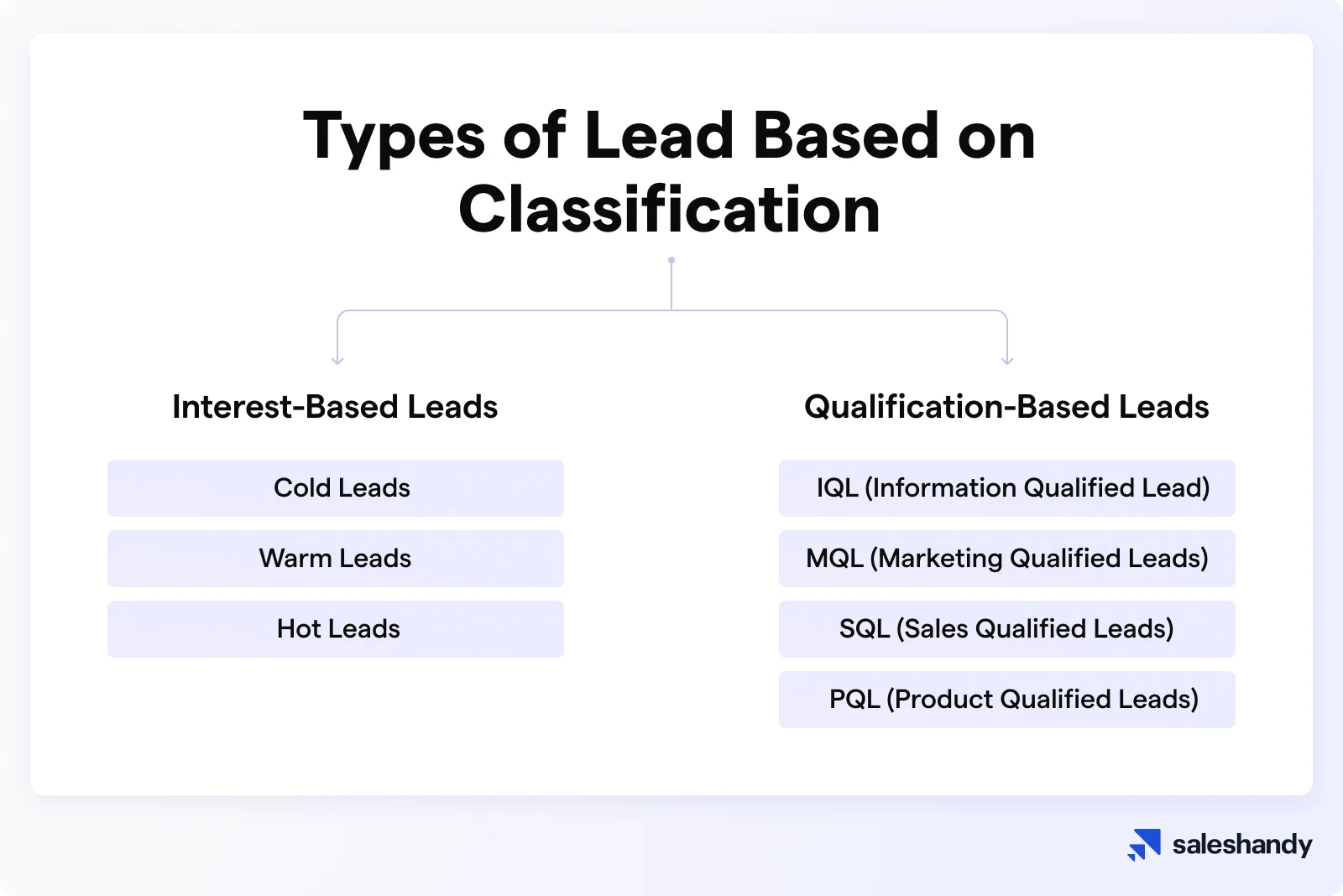
Interest-Based Leads
These types of leads are based on the level of engagement or interest a prospect has shown in your product or service. They are typically divided into:
Cold Leads
Cold leads are leads who have not expressed any interest in your product. They are considered one of the toughest to convert.
However, they perfectly fit your ideal customer profile. They are usually generated through research or lead-generation software.
Most of the leads you will encounter will fall under this category, so you need to master the art of communicating with them.
Warm Leads
Warm leads are those who are already aware of your brand by reading your blogs, following you on social media, subscribing to your newsletter, etc., and showing a growing interest in your offerings.
These leads are much easier to convert into purchasing customers than cold leads.
Hot Leads
Hot leads (also known as qualified leads) have explicitly shown an interest in your product. They could have filled out a demo form or contacted you directly.
These leads require immediate attention because their interest could fizzle out if you take too long to respond to them.
If you miss out on the opportunity, they could reach out to your competitors. So, you need to be extremely proactive!
Qualification-Based Leads
Here, the leads are categorized based on their readiness to move through the sales funnel. Their readiness is assessed through specific interactions or behaviors that align with your sales and marketing criteria.
There are 4 types of leads under this category:
IQL (Information Qualified Lead)
IQLs are just at the beginning of their buyer’s journey. They have just begun to research a solution to their problem.
These leads usually provide their contact information in exchange for something useful. They are generated when they fill out a form to download ebooks, webinars, infographics, reports, etc.
Most of the time, these leads provide you with very little information about their company or job title.
Marketers generally don’t prioritize these types of leads as most IQLs don’t move on to the next stage after they have obtained the information they sought.
MQL (Marketing Qualified Leads)
MQLs are right in the middle of the lead generation funnel and are just one step ahead of IQLs. These leads are usually identified by the marketing team as interested in your product.
Typically, these leads have to meet certain criteria, such as providing their information on landing pages, expressing an interest through social media platforms, having attended your company’s webinars, etc.
These leads can be easily converted as they require some convincing over an email or a conversation. But not all leads are alike.
Sometimes, you may have to follow up with the right message to convert them.
SQL (Sales Qualified Leads)
SQLs are leads that are considered to be ‘sales-ready.’ They are usually passed over from the marketing team to the sales team.
These leads have expressed an intent to buy what you are offering and are ready to buy. However, they could still be comparing solutions against your competitors.
Marketers and salespeople consider these leads as very ‘hot.’ Since they have already checked all the boxes and are fully qualified, all you need to do is strike while the iron is hot and start walking them through the sales process.
PQL (Product Qualified Leads)
PQLs are considered leads who have gone beyond the SQL stage and have already gained experience using your product.
This could be through a feature-limited access account or a free trial. Generally, SaaS or software companies focus more on PQLs as they most often offer free trials.
With each section, you become more knowledgeable about lead generation. The next section will give you an idea of how you can determine the quality of the leads you’ll be generating.
So keep reading further!
How to Determine the Quality of a Lead?
Only some leads you generate will be the right fit for your business.
When you start your lead generation process, you will generate many leads. But how do you evaluate those leads?
How do you separate them from high-quality leads to low-quality ones?
Sure, experience and strategy are on your side, but they aren’t enough.
If you want to find strong and long-term potential customers consistently, then you require a Lead Scoring Model.
Creating a Lead Scoring Model
Many businesses develop their own numerical system for scoring leads.
Here’s how you can create one for your business:
- Identify key indicators: Start by finding traits and behaviors that show the prospects’ interest in your business. These traits should be easily trackable and measurable.
A good example is metrics like website activity, email engagement, content downloads, etc. - Assign point values: After you have found all the metrics needed, start assigning a value to each indicator. The value you assign should be based on its importance in deciding a prospect’s quality.
For example, booking a demo is more significant than downloading an ebook or whitepaper. So, booking a demo can be worth 10 points, while downloading an ebook can be worth 5 points.
- Set scoring thresholds: This threshold will help you know when a prospect has turned into a lead and is ready for a handoff to the sales team. There are a few clever methods to figure out the right threshold for passing leads to your sales team.
A straightforward approach? Add up the points from each key activity and set a cut-off. If a prospect scores above this mark, they’re ready for the sales team to take over. - Test and refine: Remember, your lead scoring system isn’t carved in stone. It’s important to monitor its performance and tweak it based on the outcomes you’re seeing and any feedback you get.
This ensures your model stays relevant to your business goals and the market. - Integrate with your CRM: Here’s the final pro tip: integrate your lead scoring right into your Customer Relationship Management (CRM) tool.
This can help automate much of the grunt work involved in lead scoring. Plus, it means your sales team gets alerted to hot prospects without skipping a beat.
You can follow these steps to come up with a simple yet effective lead-scoring system for your business.
Now, with that out of the way! Let’s learn how we can start generating leads.
How to Generate Leads? (Lead Generation Strategies)
There are 2 ways by which you can convert strangers into prospective customers.
The first method is inbound lead generation, where customers come to you, and the second is outbound lead generation, where you find and approach them.
Let us understand the process for both.
Inbound Lead Generation and Its Strategies
Inbound lead generation is about drawing customers to you through content and interactions that are helpful and relevant.
This could be done through numerous ways, such as visiting your website, blog page, social media pages, reacting to your CTA, and many more.
With this type of lead generation, the visitor controls how, when, and whether or not they wish to engage with your content and then provides their information for further use.
Here are some of the most popular inbound lead generation methods:
1. SEO (Search Engine Optimization)
High-ranking pages generally have a steady flow of visitors.
How do you get your website or blog pages to rank on the first page of search engines?
Through search engine optimization, your SEO team would carefully curate a list of keywords for a search and optimize content for better ranking.
SEO is your key to increasing organic traffic coming to your website multi-fold!
But, there is another key component that is needed to complete this magical recipe, and that is Content Marketing.
2. Content Marketing
The aim is simple: to craft and distribute content that grabs attention and offers real value to your potential customers.
Think about unleashing a mix of content forms — from insightful blog posts and detailed white papers to informative ebooks and eye-catching infographics.
Content marketing is a thoughtful way to engage your audience, providing them with valuable insights with every piece of content they explore.
This effort gradually boosts your brand’s visibility, making it more likely for prospects to interact with your business.
Here’s a little insight: combining SEO with content marketing is a powerhouse strategy employed by virtually every digital business aiming to increase organic website traffic.
3. Social Media Marketing – LinkedIn
In the bustling world of social media, LinkedIn is where you’d go to find professionals from all industries.
This is the only place where every post, every connection, and every discussion positions you front and center of your niche.
You can use this platform to boost the visibility of your business and establish your expertise.
Additionally, you can find prospects’ email addresses on LinkedIn, which you can then utilize in other outbound lead generation strategies.
This method enhances your inbound efforts and seamlessly integrates with outbound tactics, offering a comprehensive approach to lead generation.
These are just a few of the many available inbound strategies. Most, if not many, SaaS companies generate leads through inbound marketing.
You can combine and create a comprehensive approach that attracts visitors to your website and engages them with valuable content, eventually converting them into leads.
Outbound Lead Generation and Its Strategies
The outbound lead generation approach involves proactively reaching out to potential customers rather than waiting for them to find you.
Outbound strategies allow you to target specific individuals or companies that fit your ICP but might not actively seek your services.
Here are a few popular strategies you can use:
1. Cold Outreach (Emailing and Calling)
Cold outreach is of two types. Cold Emailing and Cold Calling.
You’ll be reaching out to strangers who have never interacted with your business in either of these methods.
That’s why it’s termed as cold!
Cold emailing is about precision and customization, whereas cold calling is about immediacy and personal connection.
Unlike the immediate and interactive nature of cold calling, cold emailing allows the recipient time to reflect on your message, visit your website, and consider your proposition.
This makes it a less intrusive yet effective way to initiate a business relationship.
Also Read: Cold Email vs Cold Call: Which is More Effective in 2024?
2. Social Selling
Think of social selling like attending a virtual conference where every attendee has the potential to become a valuable customer.
Just like at an event, where you’d move from conversation to conversation, introducing yourself and sharing your knowledge, social selling allows you to do the same—digitally.
You become a trusted advisor by offering insights, answering questions, and sharing valuable information.
This foundation of trust and credibility paves the way for shifting these interactions toward sales discussions.
Pro tip: If you want to win over new customers, you should engage genuinely and contribute thoughtfully.
3. Paid Ads
One of the best lead generation strategies in digital marketing to quickly boost your content is paid media campaigns.
These could range from Instagram ads to sponsored posts on LinkedIn, Facebook ads, or PPC ads on Google.
The secret to a successful paid media lead gen campaign is to configure the technical side. Hiring a well-versed professional in this niche is the best way to use this strategy to its fullest.
Using this in tandem with other lead-generation practices can set you up for short and long-term success.
Organic lead-generation practices like SEO and blogging take time to generate results. With paid media, you are paying to get leads in the blink of an eye.
These are just a few techniques and strategies you can use for successful lead generation.
Most B2B companies combine outbound and inbound lead generation techniques to engage with prospects personally and drive conversions.
By integrating these methods, you can dynamically engage with your prospects and nurture them through every stage of the sales funnel.
Also Read: What is B2B Lead Generation? Strategies & Tools To Enable Growth (2024)
This dual approach increases the chances of conversion and helps build a robust pipeline of high-quality leads.
Next, you’ll learn how to build a lead generation plan tailored to your business needs. So don’t skip this step!
How to Build a Strategic Lead Generation Plan?
Think back to your most memorable road trip. You mapped your route, set a budget, arranged accommodations, and even listed all the sights you couldn’t miss.
In much the same way, crafting a plan for your lead generation efforts is essential.
Here are a few tips and steps that you should follow to create a strategic lead generation plan that’s tailored to your business:
1. Define Your Target Audience
Your first step is defining who you’ll target and trying to attract with your various lead generation efforts.
You can do this by asking yourself the following questions:
- Which individuals or businesses will gain the most from what I’m offering?
- What obstacles are they currently grappling with?
- What are their key characteristics?
- Demographics like job title, industry, location, etc.
- Psychographics like interests, values, behaviors, etc.
- Firmographics like company size, revenue, funded or not, etc.
- Where do they spend their time online?
- What communication channels do they trust most?
- What do they want to achieve?
With these questions answered you’ll have a vivid picture of your ICP and buyer persona.
These foundations can then help you craft messages that resonate deeply, choose the most effective channels for engagement, and develop solutions that directly address your audience’s goals and challenges.
2. Set Clear Objectives and Goals
Next is to set your sights on clearly outlining what you aim to achieve with your lead generation efforts.
You can do this by setting up SMART goals (Specific, Measurable, Achievable, Relevant, and Time-bound).
This approach ensures that each goal you set is clear, attainable, meaningful to your business, and achievable within a specific timeframe.
For instance, instead of vaguely aiming to “increase sales,” a SMART goal would be “to generate 200 new leads by the end of Q2, leading to a 10% increase in sales.”
This provides a direct pathway for your strategy and makes it easier to track progress and adjust tactics as needed, ensuring your lead generation efforts are both focused and flexible.
3. Select the Right Channels
Choose channels that will most effectively reach your prospects based on your analysis of your target audience.
Some commonly used channels to generate leads are content marketing, SEO, email marketing, social media, PPC campaigns, or industry events.
You should concentrate on channels where your audience is most active. This can help you engage better with your prospects.
4. Create Compelling Content
Content is vital in attracting and engaging your audience.
Produce valuable, informative content that addresses their questions and challenges, employing a variety of formats to engage different segments of your audience.
5. Leverage Lead Magnets
Use lead magnets, such as free trials, demos, templates, or exclusive reports, to incentivize prospects to provide their contact information.
These should offer immediate value and directly relate to your prospects’ interests.
6. Implement a Lead Capture System
Optimize landing pages and forms to convert visitors into leads effectively. They should be user-friendly, communicate the value of your offer clearly, and simplify the submission process.
Also, integrating with your CRM system allows you to manage leads efficiently and directly.
8. Monitor, Analyze, and Optimize
Continuously track your lead generation activities against your set goals. You should consider using analytics to identify what works and what doesn’t.
This can help you refine your strategies based on data to improve efficiency and return on investment.
9. Align Sales and Marketing Teams
Make sure your sales and marketing teams work collaboratively, with shared goals and open communication.
This alignment is essential for smoothly transitioning leads from marketing to sales, enhancing the likelihood of conversion.
Following these steps, you can build a strategic lead generation plan that attracts, nurtures, and converts leads into paying customers.
How Do You Convert a Lead Into a Paying Customer? (Lead Nurturing)
Now that you know how you can generate your first few leads, it’s time to look at how you can convert them into paying customers.
This is where Lead Nurturing comes into the picture!
Lead nurturing is the process of building and maintaining relationships with leads throughout their journey in the sales funnel.
A well-thought-out lead nurturing strategy will focus on marketing and communicating directly with the prospect, providing them with valuable information and answering any questions they may have.
Nurturing leads is essential to your business’s success because the strategies implemented will directly influence a lead’s decision to convert into a paying customer.
Lead nurturing helps in:
- Building trust and credibility.
- Increasing brand awareness and reputation.
- Maintaining a strong relationship and connection until the lead is ready to purchase.
Here’s a quick rundown on converting leads into paying customers through lead nurturing.
1. Always Start by Communicating Your Values First.
Let’s face it: no one likes it when you’re just after a sale!
Instead, you should focus on bringing value to your lead.
How will your product or service improve your leads’ lives and meet their needs? Shed light on how exactly what you offer will act as a relief or added benefit to their lives.
Modern customers are more likely to support businesses that are aligned with their values and can offer support if they choose your brand.
Always speak to your buyer’s needs!
2. Identify Their Specific Pain Points.
What exactly is your lead’s pain point? Are they trying to save time or automate their efforts?
As you open the lines of communication with them, ask them more about their pain points. This will help you understand them better.
3. Keep the Content Shared Relevant.
You don’t want a prospect to lose interest because you have shared too many irrelevant resources with them.
Also, often, sales reps end up overshooting their value proposition.
The subject matter, flow, tone, all of these things matter!
You should strategically create and share content that nudges your leads toward your offerings.
For example, if a lead is interested in buying your CRM software but isn’t convinced, you can share a case study from their industry with them.
4. Keep the Content Shared Relevant.
Leads are more likely to be responsive if you encourage a two-way conversation. Open dialogue keeps prospects engaged, allowing your sales team to learn more about their needs in a casual space.
Avoid the traditional sales pitch at all costs!
5. Keep Your Leads Warm.
Even after a conversation with a prospect who has expressed an interest, they may still not be sales-ready. But because they are already interested, you should keep them warm.
The general rule of thumb suggests that a prospect usually sees or hears from you at least 7 times before converting. Following up is very important.
Keep them informed and let them know that you are always available to answer any questions. When they are ready to move to the next step, show them that you care.
6. Ask the Big Question! (The Sale)
Asking for a sale is a crucial part of the conversion process. You would think this is common sense, but many people don’t ask for the sale.
Remember, if your leads weren’t genuinely interested in buying your product, they wouldn’t have made it this far into the sales funnel.
Ask before your competitors do!
7. Follow-Up
It is essential to keep your leads in ‘purchase mode’ by following up via email or phone call. You don’t want too much time to pass.
You should follow up with all the high-quality leads you generate within a few days later.
Our internal experts recommend a 7-phase follow-up strategy.
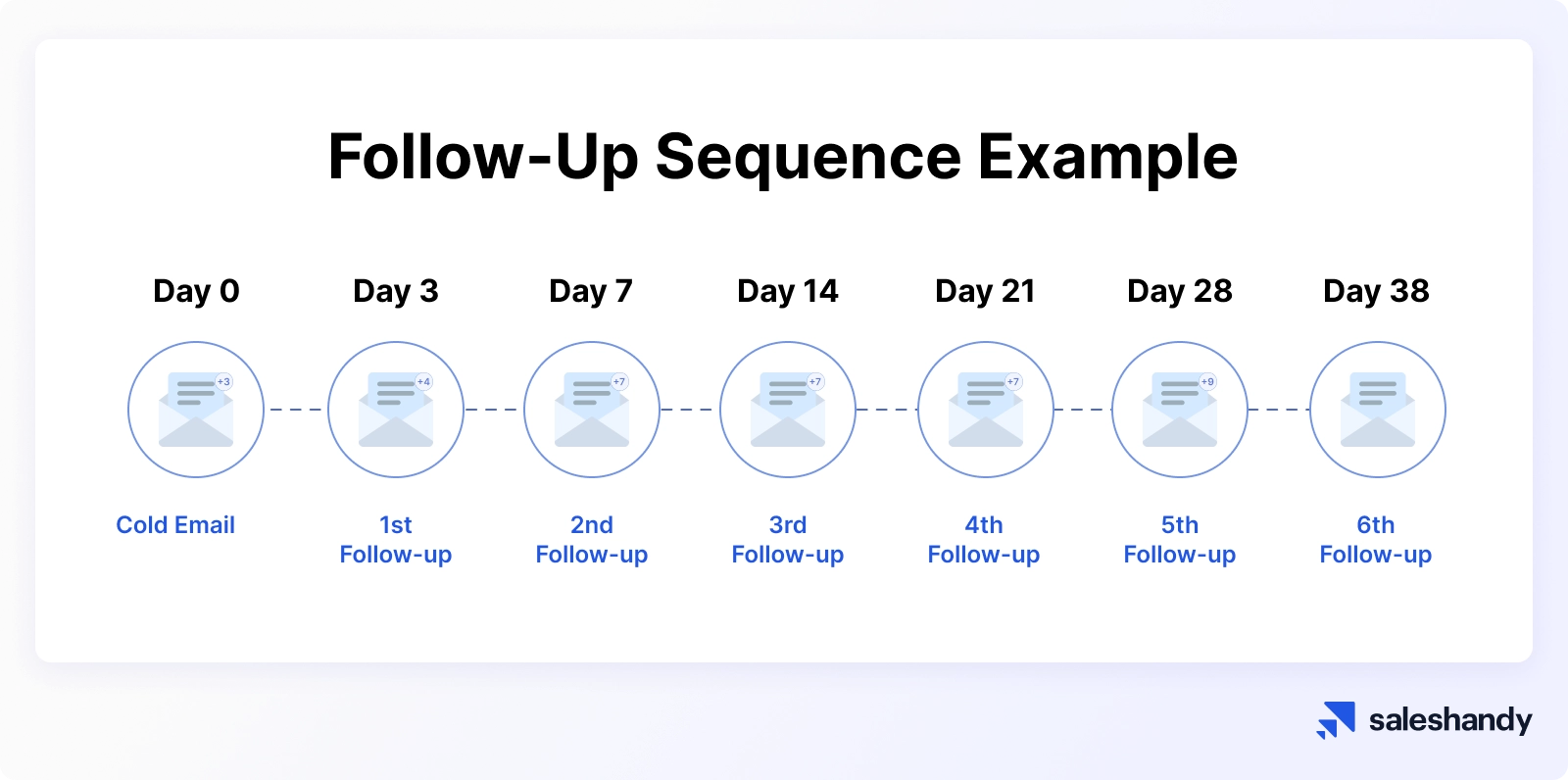
Reach out to them and check if they have any questions about your offering that needs to be answered.
By proactively following up, you show that you care about them, and this can create a positive impact on your prospects
8. Strike While the Iron is Hot.
Don’t wait around too long to reach out to your leads! It’s a competitive and abundant market out there.
If your assessment reveals that the lead has enough awareness and interest, contact them as soon as possible (interest levels can drop drastically even after an hour). Your team can develop an internal process for following up on leads.
9. Make a Good Impression.
Several studies have revealed that leads are likelier to convert into customers if they don’t feel rushed.
Every lead you reach out to should feel individually respected and remembered.
This favors you in the sales sense and leaves a good impression on the lead about your company.
Now that you know how to generate and convert leads into paying customers, it’s time to get acquainted with the common challenges that you may face in your lead generation journey.
Read on to learn how you can overcome these hurdles.
What Are the Common Challenges in Lead Generation, and How Can They Be Overcome?
This guide would not be complete without discussing the common challenges you might face when generating leads.
In this section, you’ll look at 5 common challenges and best practices you need to know when you start your lead generation process.
5 Common Challenges in Lead Generation
1. Lack of Targeted Traffic
Sometimes, it feels like you’re shouting to the sky, right? Thinking someone may hear what you’re saying, and if they are interested, they’ll turn and come your way. This is a highly inefficient way to generate leads.
The key here is to draw in the right audience—those genuinely interested in what you offer. To overcome this, you should conduct market research on your target audience and develop ICPs and buyer personas.
This can help fine-tune your marketing to resonate with the people most likely to engage.
2. Low Conversion Rates
Think of your website as a marketplace that people visit. If visitors aren’t converting into leads, it might be time to look at the layout of your digital stall.
Common problems can be poor website design, complicated forms, the absence of enticing offers, etc.
To tackle this, optimize your website’s user experience, simplify forms, and present compelling offers that resonate with your audience.
3. Ineffective Lead Nurturing
Lead nurturing might be another hurdle, especially in guiding leads through the sales funnel with timely and relevant content.
Here, you should segment your lead and then engage them with personalized messages that resonate with them.
4. Lack of Integration between Marketing and Sales
Good alignment between your marketing and sales teams can prevent potential leads from slipping through the cracks.
You should ensure proper cooperation and communication between teams and establish a clear lead-handoff procedure to ensure no missed opportunities.
5. Limited Budget and Resources
Trying to stretch your lead generation efforts on a thin budget can be challenging.
But you can easily solve this problem. How?
Use cost-effective strategies like SEO, content marketing, and social media, which are your allies here, offering cost-effective ways to reach and engage potential leads without breaking the bank.
Each of these challenges is just a step in your journey. With the right approach, you can sail through them smoothly toward your lead generation goals.
5 Lead Generation Best Practices You Must Follow
1. Optimize Lead Generation Forms and Landing Pages
Keep forms simple and your landing pages enticing.
Highlight the value you’re offering, flaunt your happy customers’ testimonials, and ensure your site is a breeze to navigate on any device. It’s all about making that first digital handshake as welcoming as possible.
2. Create Quality, Relevant Content
Your content should be like a beacon, drawing in those seeking guidance or solutions.
Whether it’s through in-depth ebooks, insightful whitepapers, or engaging webinars, make it so valuable that sharing their contact info feels like a fair trade to your visitors.
3. Implement Live Chat for Real-Time Engagement
Have you ever thought how great it would be to answer visitor questions on the spot? You can do just that with live chat.
It’s like being a helpful guide in a vast digital mall, ready to point them in the right direction and dramatically boost your chances of converting a browser into a lead.
4. Use CRM Software to Nurture Leads
Imagine having a digital butler that helps you remember every preference of your guests.
That’s what CRM software does for your leads. It keeps track of their likes, dislikes, and needs, helping you send tailored messages that hit the mark every time.
5. Encourage Online Reviews and Display Social Proof
There’s nothing more convincing than seeing others happy with their choice.
Encourage your satisfied customers to share their experiences and proudly display these stories as social proof.
This will reassure potential leads that they’re making the right decision by choosing you.
In the next section, we’ll cover how you can measure and optimize your lead generation efforts.
So, don’t go anywhere! Keep reading.
How Can You Measure and Optimize Your Lead Generation Efforts?
You have seen how the lead generation process works, how to plan your lead generation efforts, various strategies to get leads, and how you can convert them into customers.
But how would you know if what you’re doing is actually working?
How would you know if there is any room to optimize the process and make it more efficient?
This is where measuring the performance of your lead generation campaigns can come in handy.
Understanding how to track performance and make data-driven decisions will help you maximize your return on investment (ROI) and achieve better results over time.
What Are the Key Performance Indicators (KPIs) for Lead Generation?
There are several key performance indicators (KPIs) that are essential for measuring the success of your lead-generation efforts. Some of the most important metrics are:
- Conversion Rate: The conversion rate is the ratio of visitors who buy your product or sign up for a free trial to those who browse your website.
A higher rate suggests you’re hitting the mark with your audience and crafting offers that are too good to pass up. It’s a clear signal you’re on the right track with your marketing. - Cost per Lead (CPL): This metric measures the efficiency of your strategy. It measures the amount of money you’ve spent to acquire a lead.
It’s simple: the less you spend to get someone interested, the smarter and efficient your strategy. - Lead-to-Customer Ratio: This tells you how many of your leads turn into actual sales. The higher the ratio, the better.
It’s calculated by dividing the number of new customers acquired through lead generation efforts by the total number of leads generated during a specific period. - Time to Conversion: Ever wonder how long it takes for someone to go from “just looking” to “take my money”?
This metric helps you pinpoint delays in your process, showing you where you can make things snappier. - Return on Investment (ROI): This is the big one—it tells you if the money you’re putting into lead generation is paying off.
You want to see that the revenue from your leads far outweighs the cost of getting them.
You’re almost there!
In the coming sections, you’ll learn about the various tools that can help save your time and effort.
Check them out.
What Are Some Essential Lead Generation Tools?
The key to succeeding in lead generation is being efficient. Manually handling the multiple stages in the lead generation process can be daunting and time-consuming.
But worry not! There are a few tools in the market that can do the heavy lifting for you.
With these lead generation tools by your side, you can enhance your efforts and ensure a smoother transition for your prospects to become paying customers.
In this section, we’ll cover the top prospecting and outreach tools that can help you find prospects relevant to your ICP and reach out to them with tailored messages.
Plus, we’ll look at how CRM and lead management tools make it easier for you to keep all your customer info in one place. This means your whole team can easily find what they need, helping everyone stay informed and work better together.
So, let’s jump right in!
Top Prospecting and Outreach Tools
Manually prospecting and reaching out to prospects is a long, drawn-out, and often monotonous process.
It takes up too much of your valuable time, time that you can use for other sales activities that could drive profits. This is where prospecting and sales outreach tools can help you save time and effort.
Top 2 All-in-One Platforms
If you are looking for a comprehensive solution for pinpointing and reaching out to potential prospects, these platforms can offer a streamlined approach.
Saleshandy
Saleshandy is an All-In-One prospecting and cold email outreach platform.
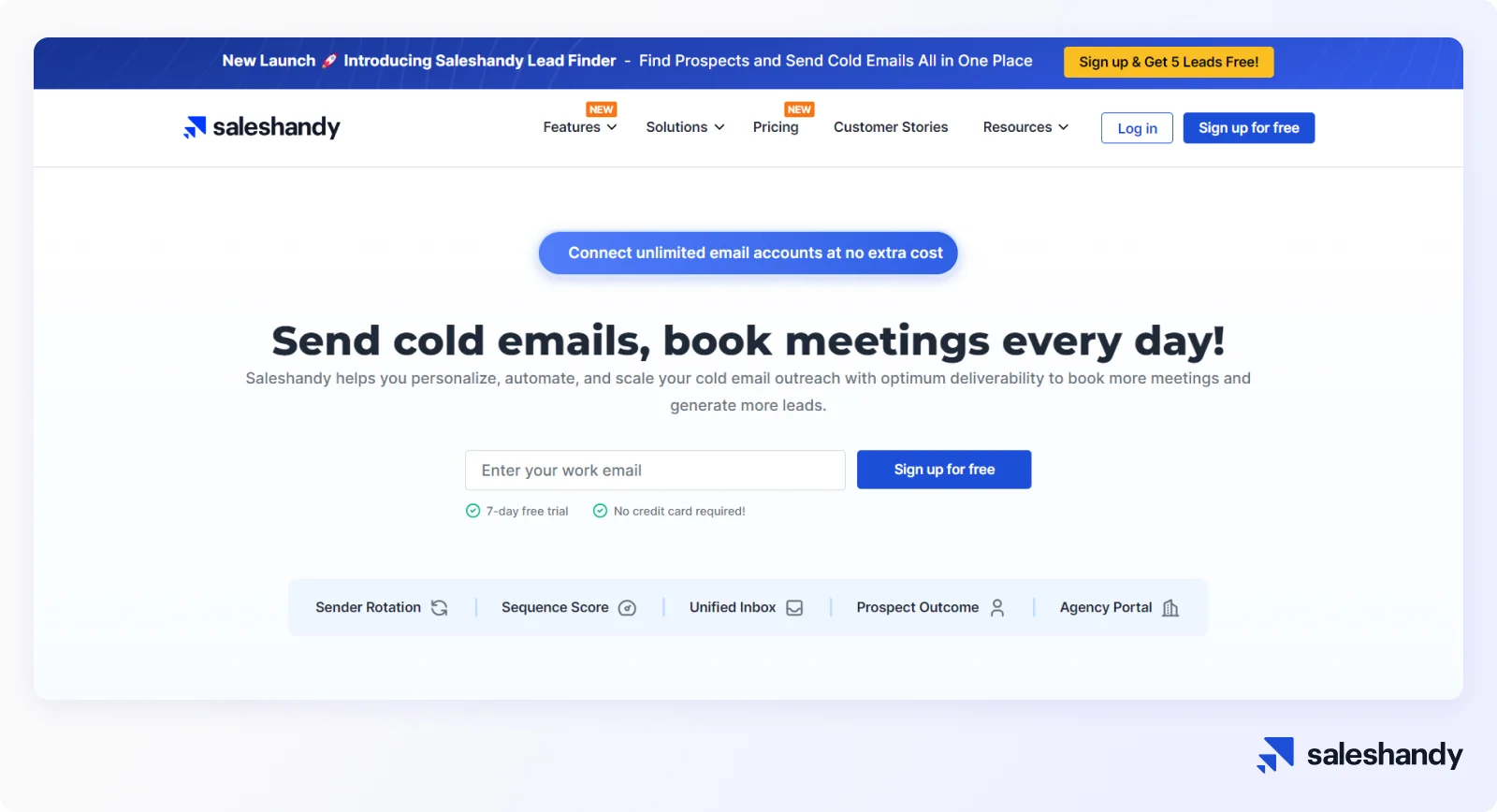
The prospecting platform – Lead Finder has over 700M verified professional profiles from across 60M businesses globally.
By using advanced filters, such as location, industry, company revenue, etc., you can find prospects that match your ICP.
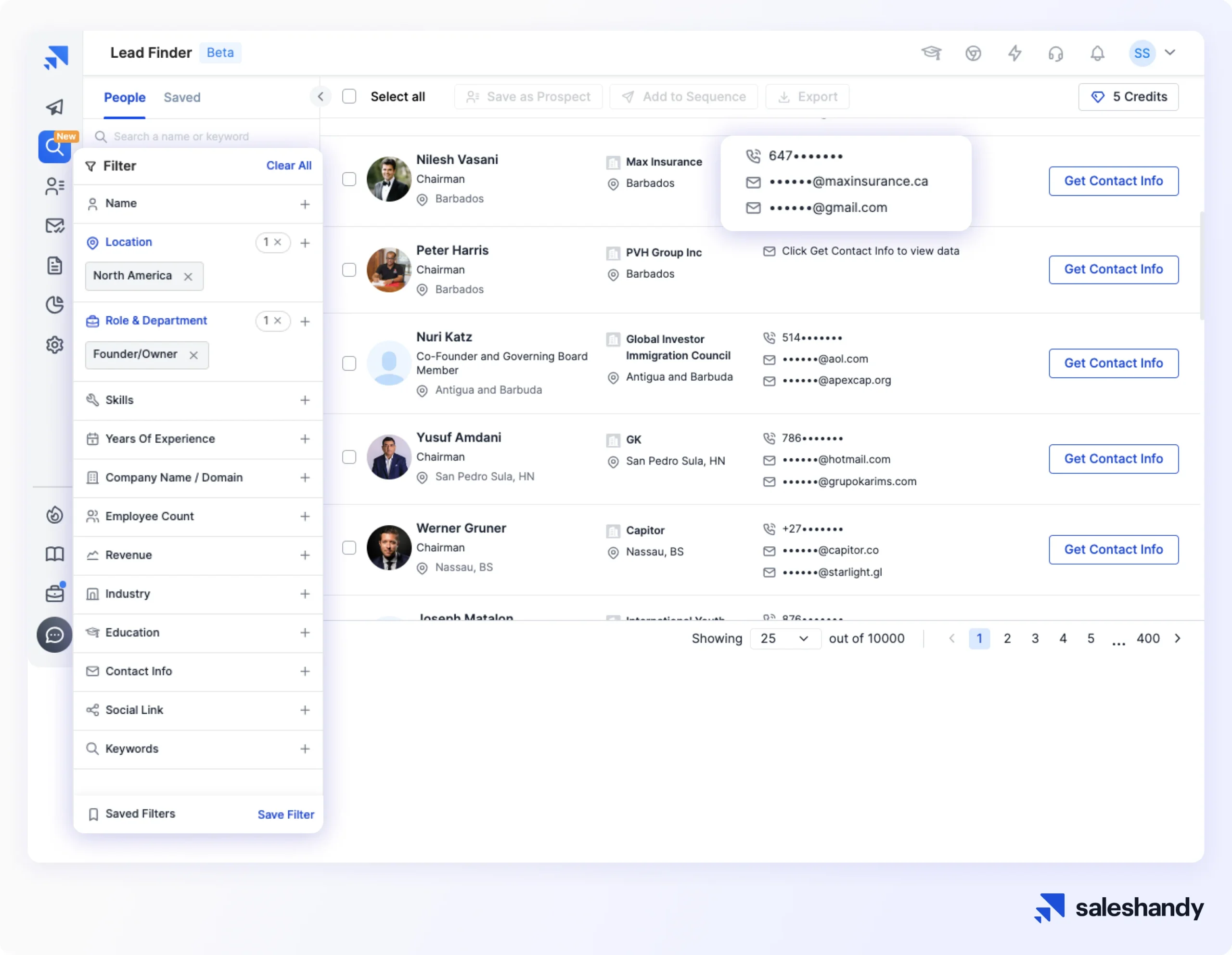
After you have your lead list, you can use Saleshandy’s cold email platform to create automated cold email sequences to start your outreach campaigns.
With Saleshandy as your go-to tool, you can bring efficiency, precision, and reliability to your lead generation and sales outreach strategies.
Apollo.io
Similar to Saleshandy, Apollo.io is a data intelligence and sales engagement platform that can help you with prospecting and outreach.
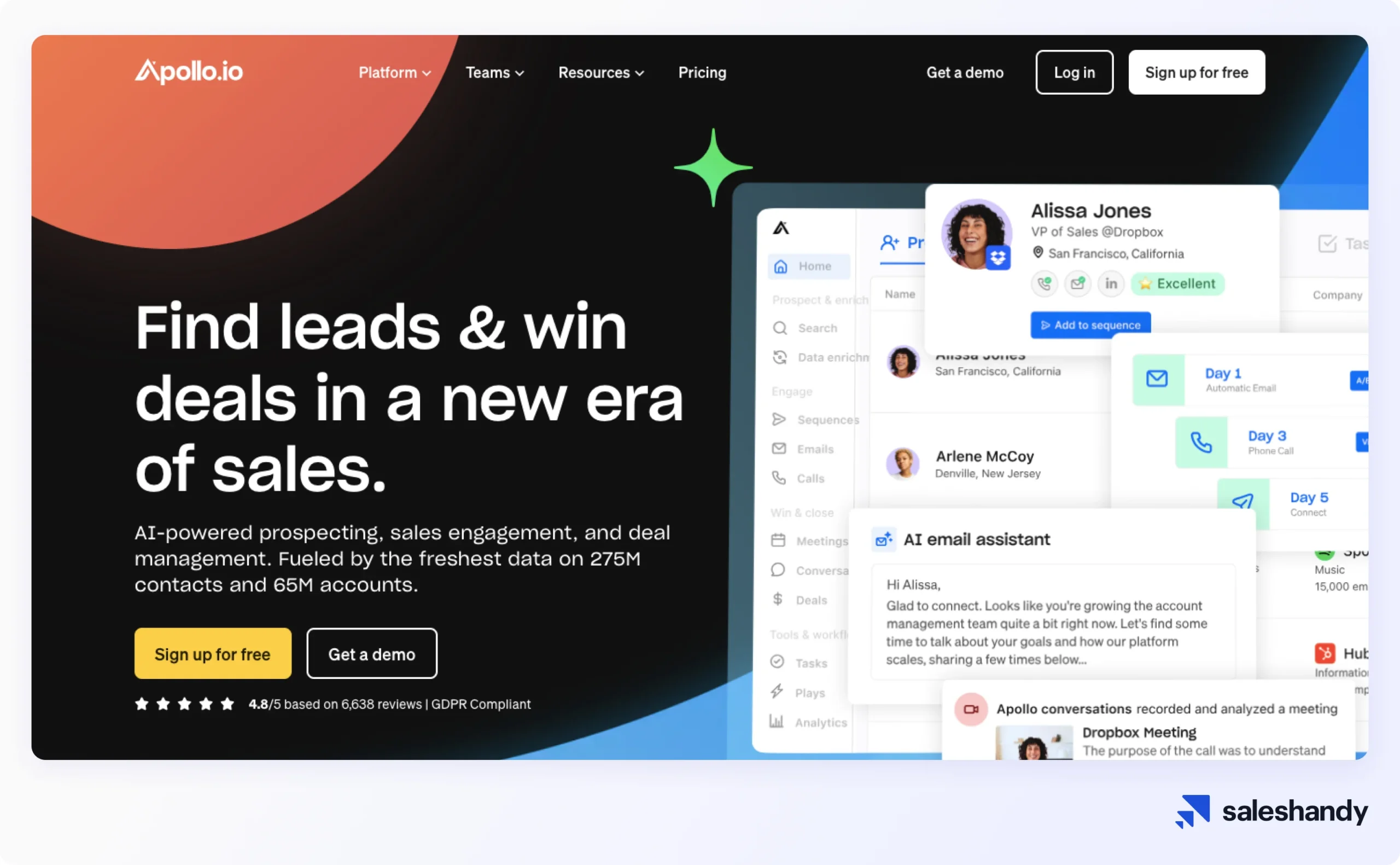
You can use Apollo to find prospects and decision-makers related to your ideal customer profile, along with their key information like direct dial phone numbers, business emails, and more.
Also Read: 10+ Apollo.io Alternatives to Find Verified B2B Leads (2024)
Top 2 Standalone Prospecting Tools
If you are looking for standalone sales prospecting tools to find your ideal prospects, then these tools can definitely help you.
ZoomInfo
ZoomInfo is a comprehensive B2B database that provides detailed information on businesses and decision-makers.
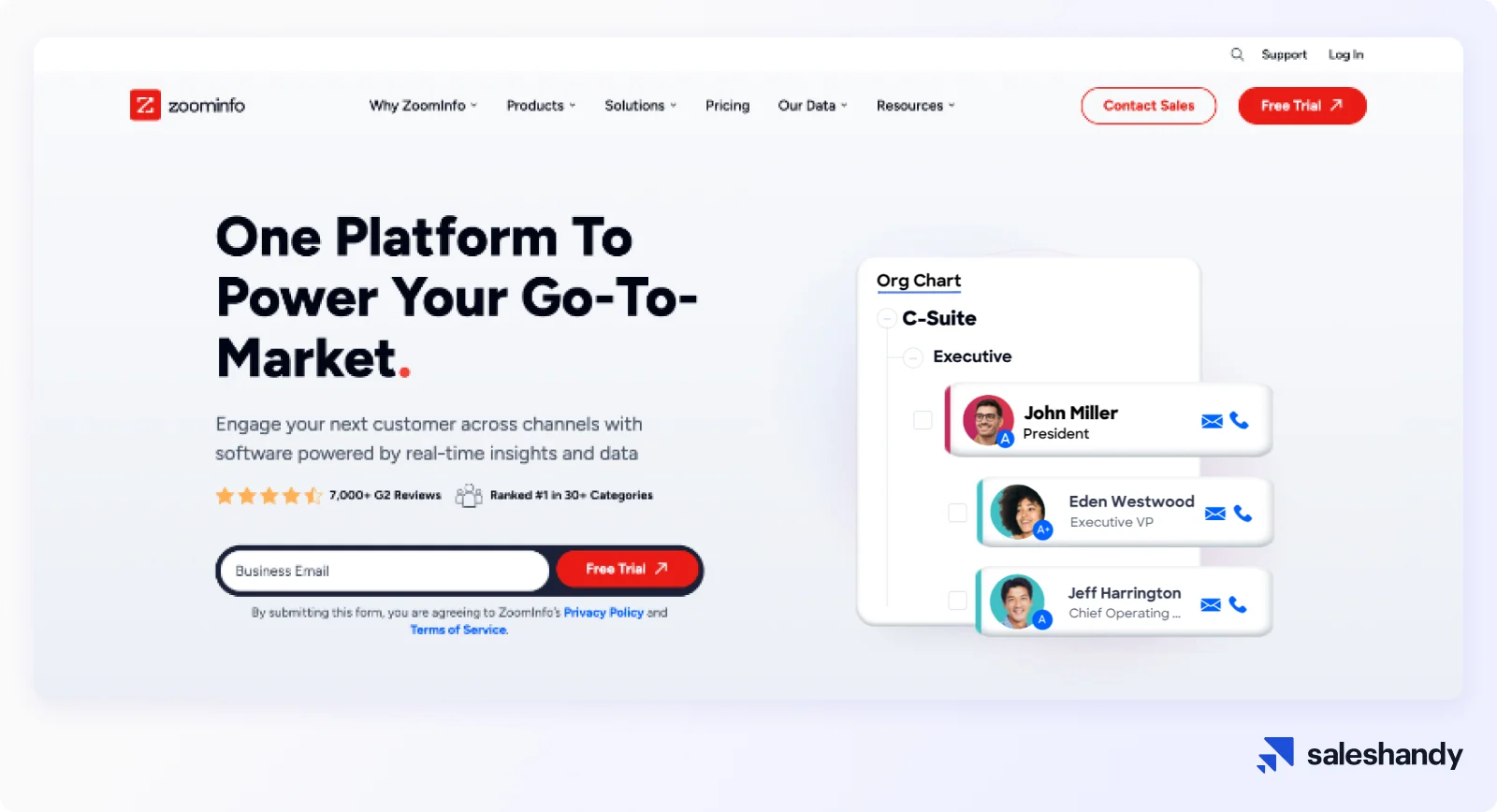
It provides in-depth intelligence on prospects like titles, roles, and org charts to improve your outreach. ZoomInfo also offers useful enriching and cleansing tools to update and validate outdated CRM data.
Also Read 15 Best ZoomInfo Alternatives & Competitors of 2024 (New List)
If you’re looking for enterprise-level prospecting software, Zoominfo can be a good tool.
Lusha
Lusha is another popular standalone prospecting tool. It is a powerful tool that can help you significantly improve your sales process and outreach.
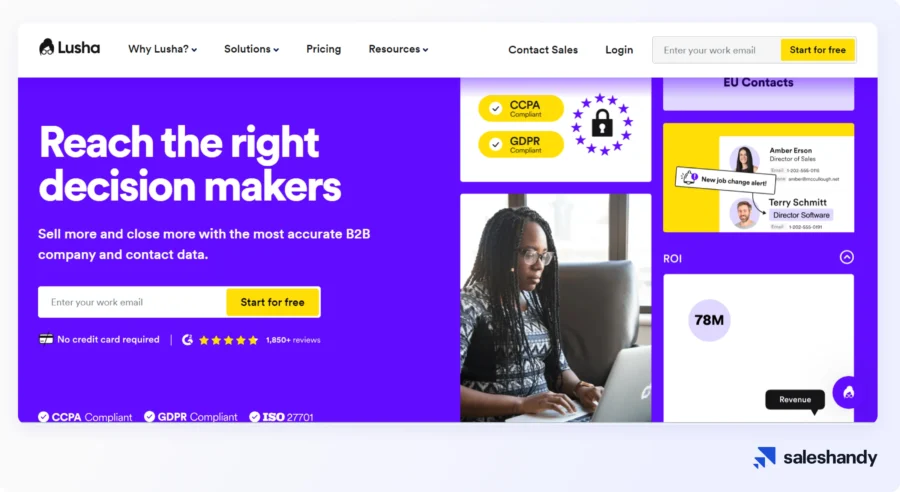
It also has a Google Chrome extension and Email Finder tool that lets you find contact details and company information while prospecting on LinkedIn.
Also Read: 10 Best Lusha Alternatives and Competitors in 2024
Top 2 Standalone Cold Email Outreach Tools
Smartlead
Smartlead is a standalone cold email outreach platform that you can use to reach out to your prospects using personalized messages.
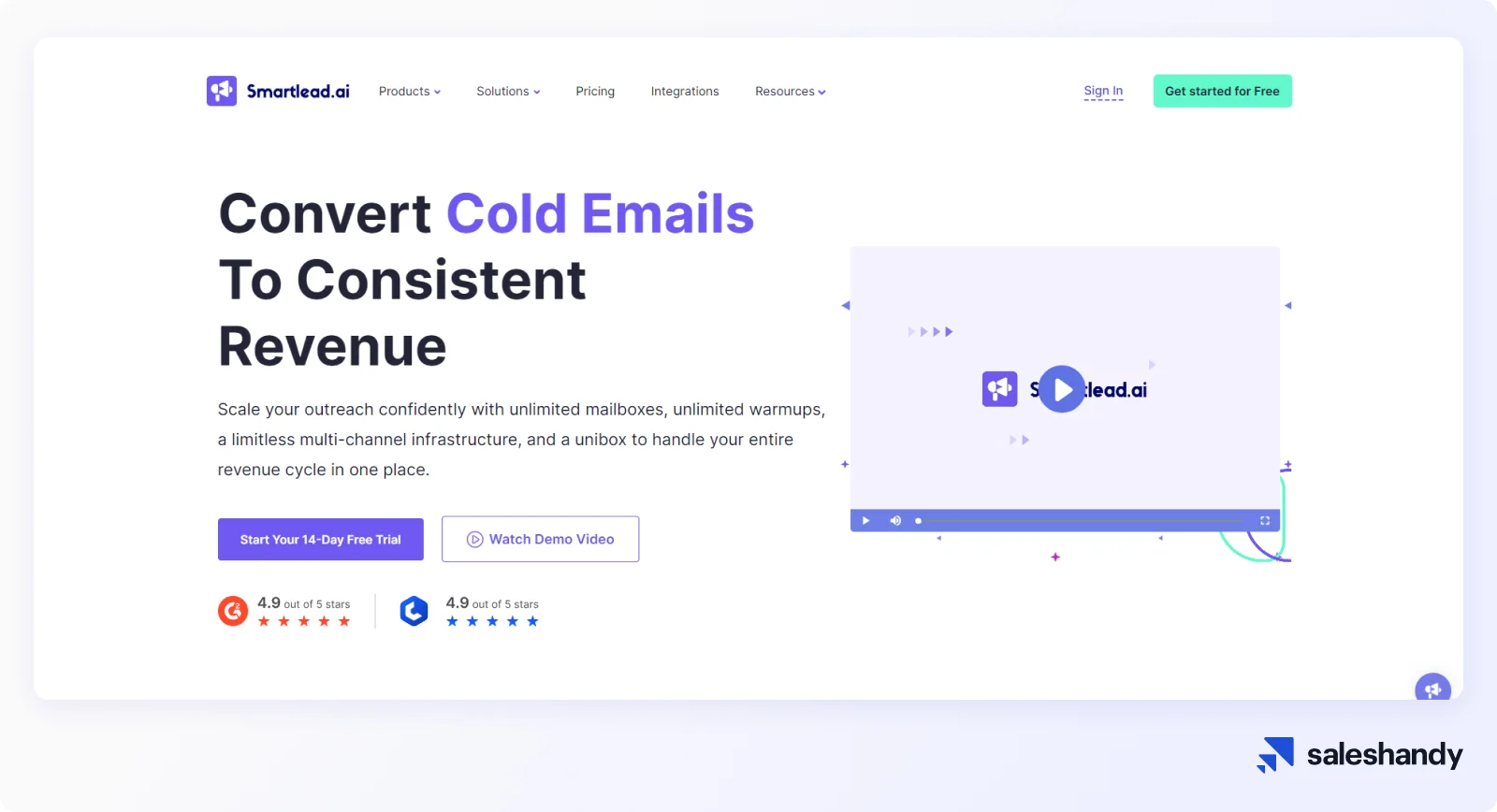
It has features like unlimited email warm-ups to ensure your messages land in your prospects’ inboxes.
Also Read 10 Best Smartlead Alternatives and Competitors in 2024
You can also easily scale your outreach with Smartlead, as it allows you to connect multiple email accounts. This approach also ensures your email accounts’ sender reputation and deliverability are not affected.
Woodpecker
Woodpecker is another cold email outreach tool that you can use to automate your cold email campaigns with personalized email copies.
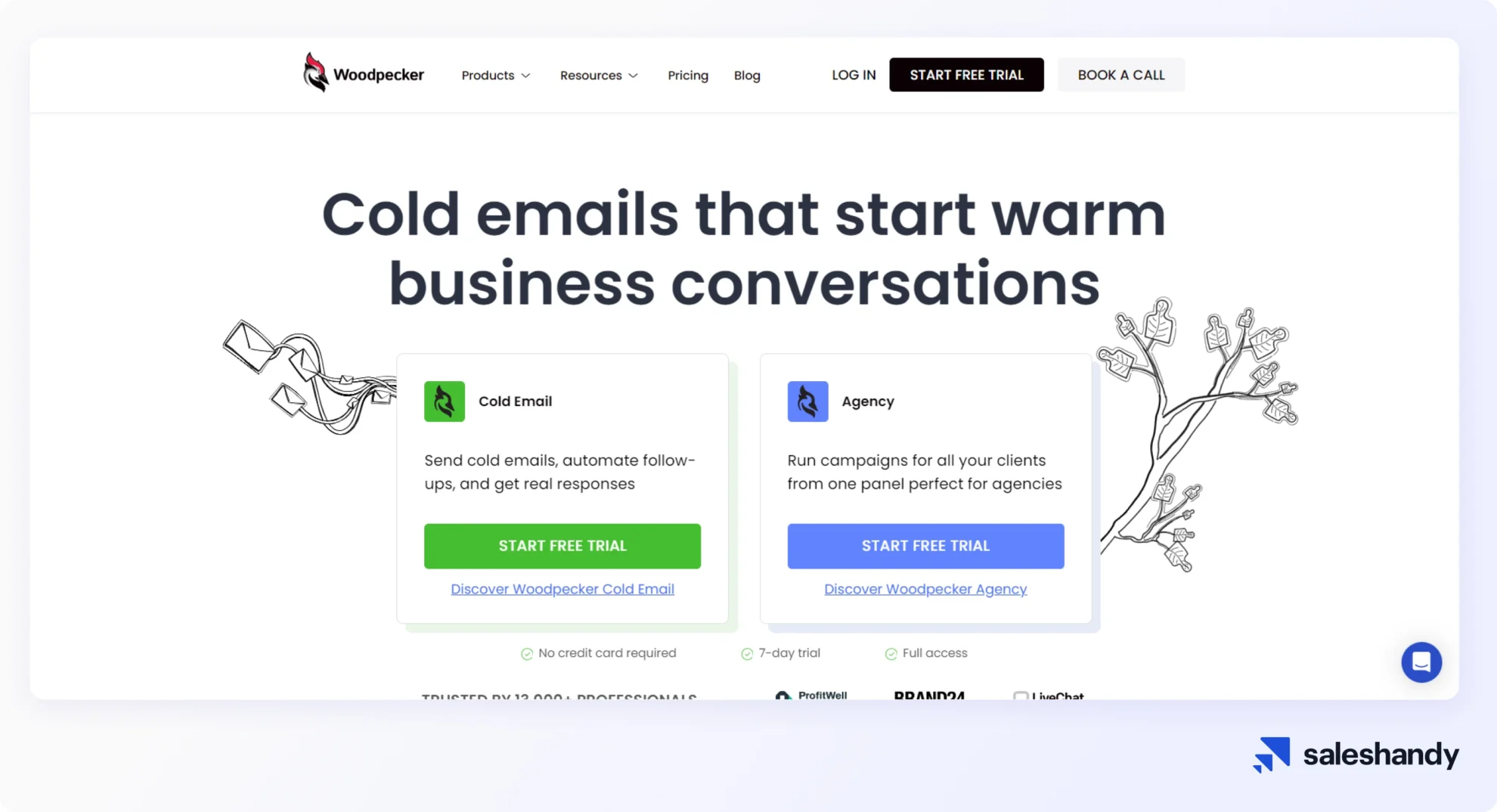
It supports integration with Gmail, Outlook, and other email services, using personalized and automated strategies to improve the chances of your emails landing in inboxes rather than spam folders.
Also Read 12 Woodpecker Alternatives for Higher ROI [2024]
This tool can help streamline your email campaign management process, making connecting with prospects and clients more efficient.
Top CRM and Lead Management Tools
CRM and lead management tools can help you organize and make sense of your potential customer data.
Plus, these tools can automate follow-up tasks and sort your leads into different groups based on their actions and profiles, making it easier to turn those leads into customers.
Zoho CRM
ZohoCRM is your go-to tool for keeping track of all your customer interactions, sales deals, and tasks in one place.
It helps you stay on top of leads, manage your sales process smoothly, and ensure your team is aligned.
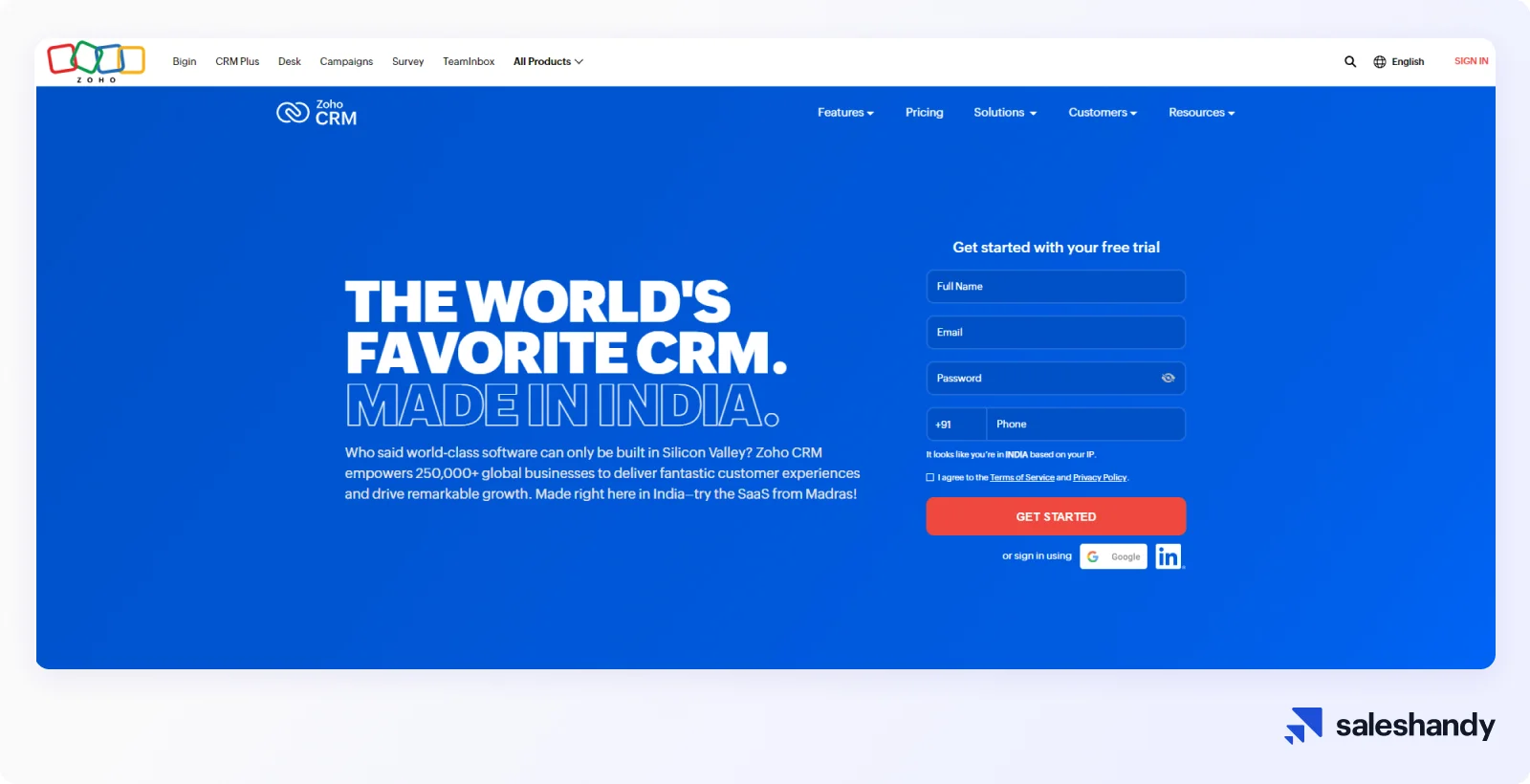
With Zoho CRM, all your customer interactions are organized and made accessible, helping you never miss out on a sales opportunity.
The platform is designed to be user-friendly so you can focus on building stronger customer relationships and growing your business efficiently.
HubSpot
HubSpot CRM is like your all-in-one tool for keeping track of your business relationships and interactions.
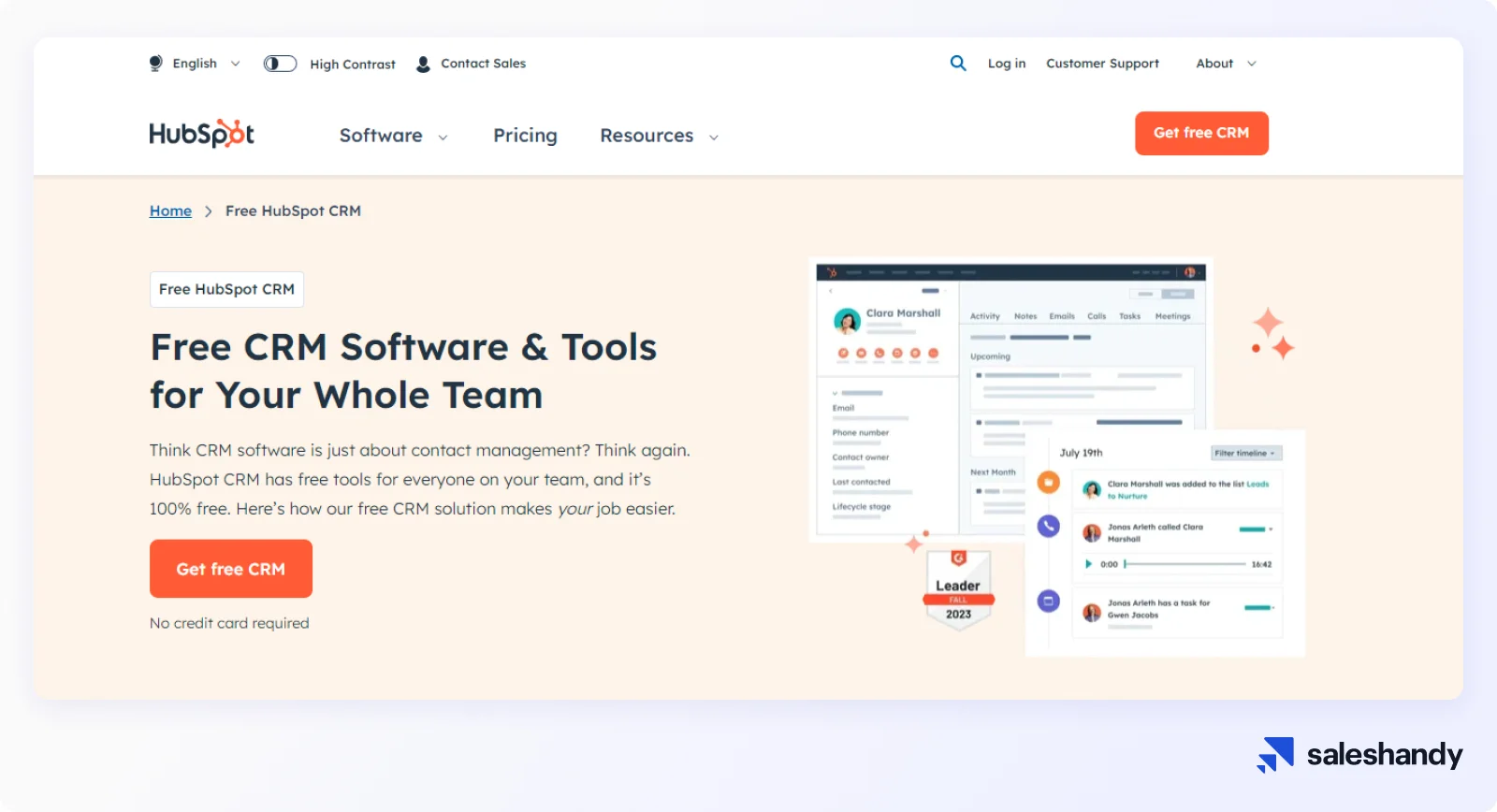
It’s designed to make your life easier by organizing all your customer information in one place. You can keep an eye on your deals, see what your customers are up to, and send emails without leaving HubSpot.
These are some of the necessary tools you’ll need to start your in-house lead generation.
But, if you’re a small business with budget constraints and cannot hire internally, you can consider partnering with lead generation agencies.
In the next section, you’ll look at a few top lead generation agencies you can consider hiring.
Which Lead Generation Companies Should You Consider Hiring? (Based on Region)
Getting high-quality leads can be quite challenging if you do not have the required expertise.
This is where lead generation agencies can help you!
These agencies can deliver vetted leads you can nurture and convert more readily. Furthermore, partnering with an agency can, at times, be more cost-effective than hiring an internal team of experts.
We have listed a few of the top agencies around the world, region-wise. So, without further ado, let’s jump in.
Top Lead Generation Companies in the UK
1. Pearl Lemon Leads
Pearl Lemon Leads is an agency specializing in B2B lead generation, SEO, and PPC.
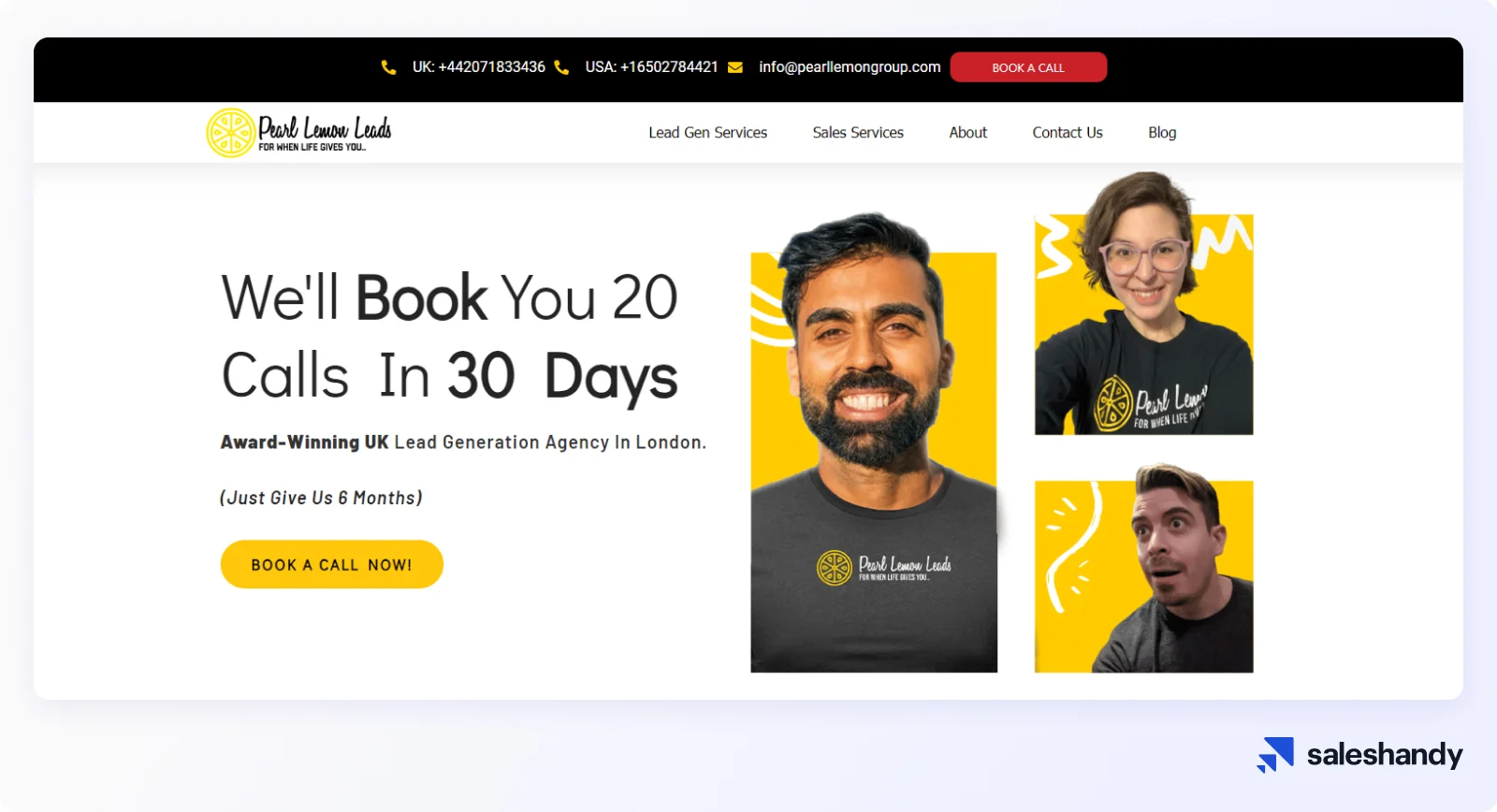
They leverage LinkedIn to connect you with key professionals and decision-makers, boosting your business’s visibility.
This agency is an expert in generating leads through LinkedIn. They primarily focus on expanding your network, creating and sharing content based on your industry, and increasing your trust and credibility.
2. Paragon Sales Solutions
If your business heavily relies on telemarketing, then Paragon Sales Solution can be your lead generation partner.
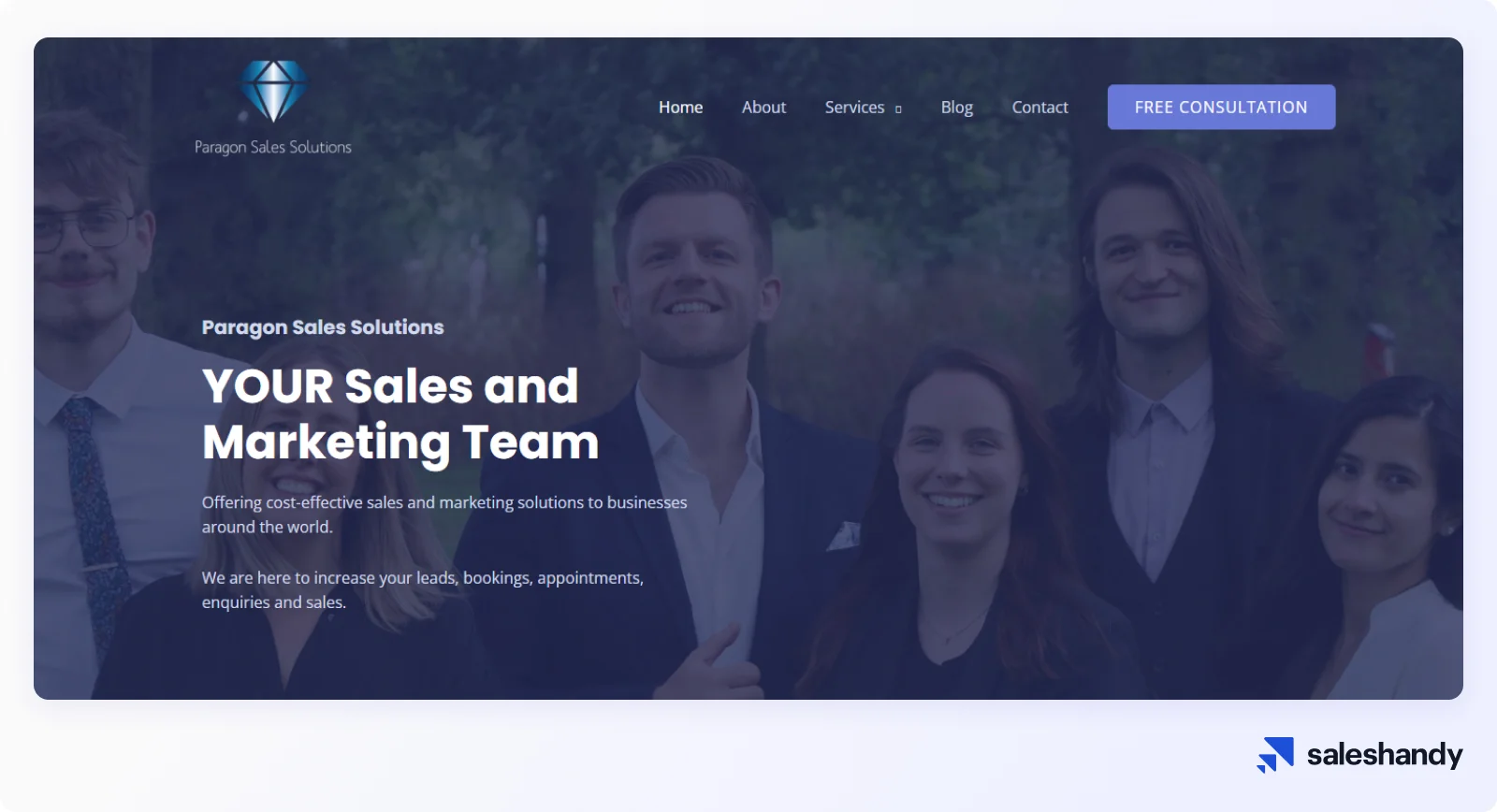
What sets them apart is their complete transparency in sharing lead campaign performance and insights. You can also choose the type of leads you want.
Based on your goals, they can provide raw prospect leads or leads nurtured and followed up by their team.
Apart from telemarketing, they are also experts in social media marketing and paid ads.
If you want to explore top-notch lead generation agencies in the UK more, then consider reading Top 10 Lead Generation Companies in the UK.
Top Lead Generation Companies in the USA
1. CIENCE
CIENCE is a B2B lead generation company that provides tailored services for sales development. They provide dedicated outsourced SDR services for businesses that need internal sales staff.
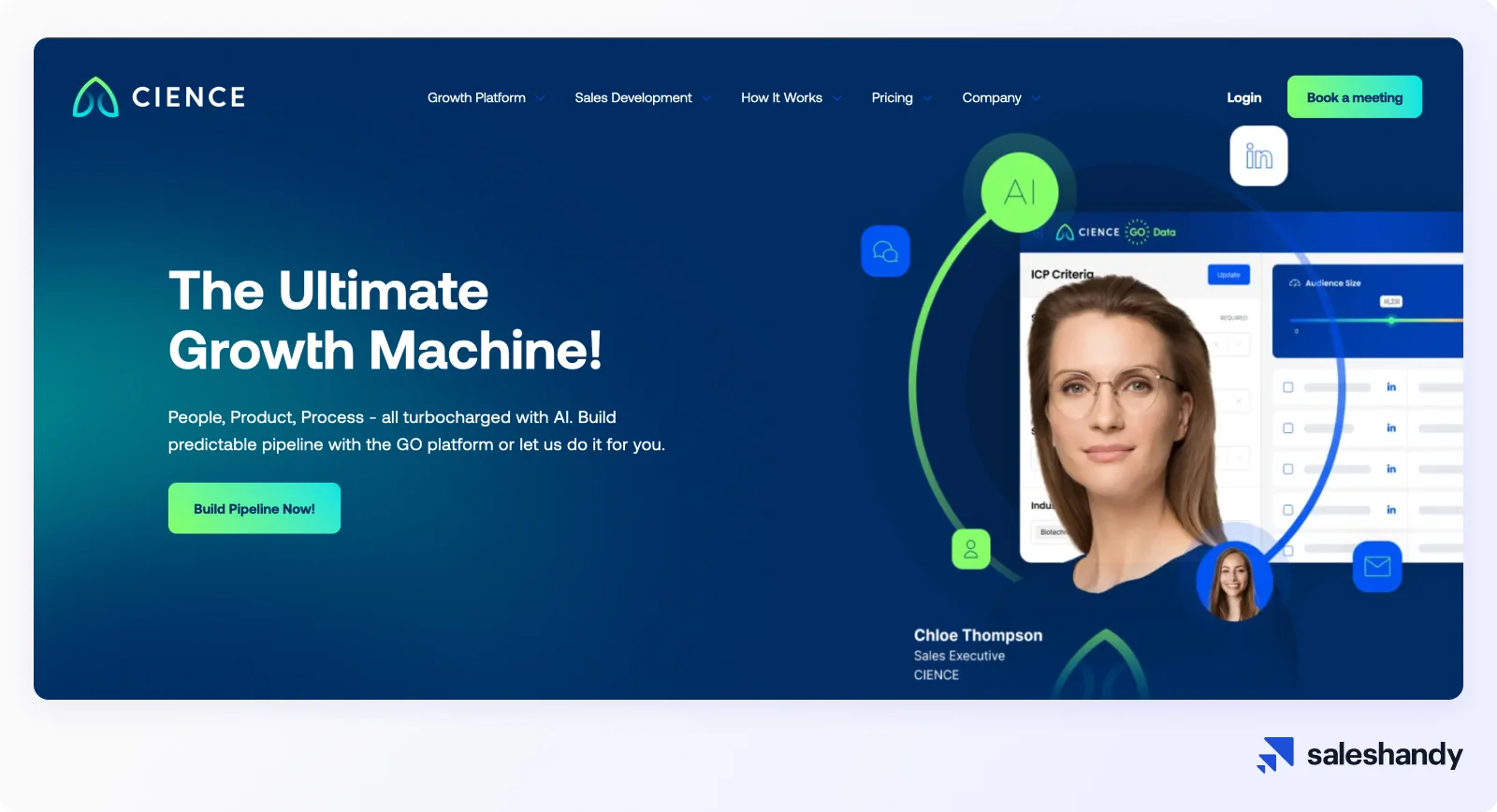
These trained specialists manage the entire lead nurturing process using targeted messaging across different channels, including email, social media, and others.
If you’re looking for an agency in the United States that takes an innovative approach to lead gen, CIENCE is a good choice.
2. Belkins
This B2B lead generation and sales agency offers a range of services, from researching leads to cold emailing and working on LinkedIn marketing.
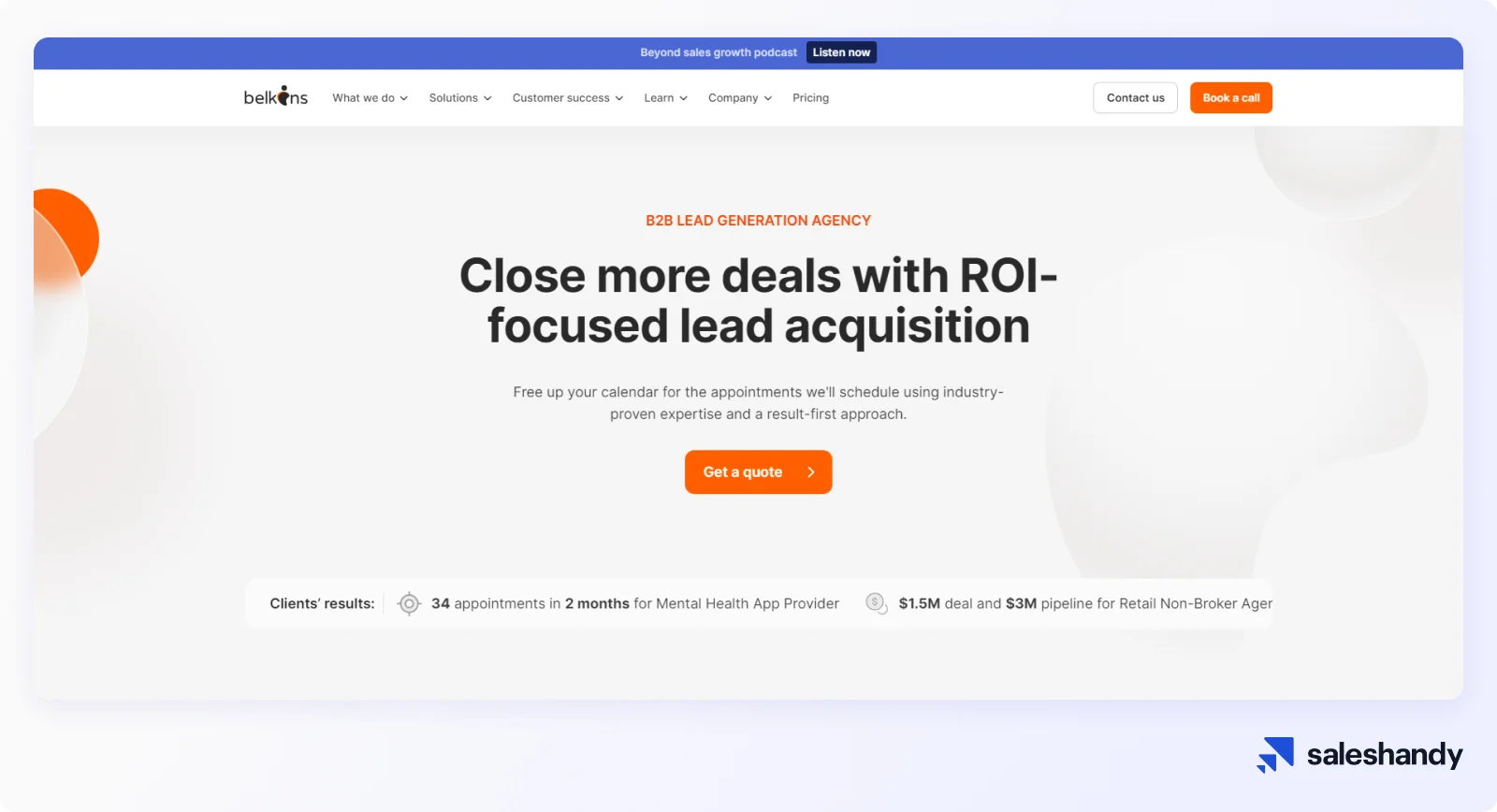
Belkins, make sure that throughout your lead generation campaign, they keep the communication channels open so that you’re always in the loop.
Consider reading our 10 Best Lead Generation Companies in the USA For 2024 blog if you want more detailed information about some of the best agencies in the USA.
Top Lead Generation Companies in the UAE
1. EDS
EDS is a digital marketing company that can help your business with tailored lead-generation solutions.
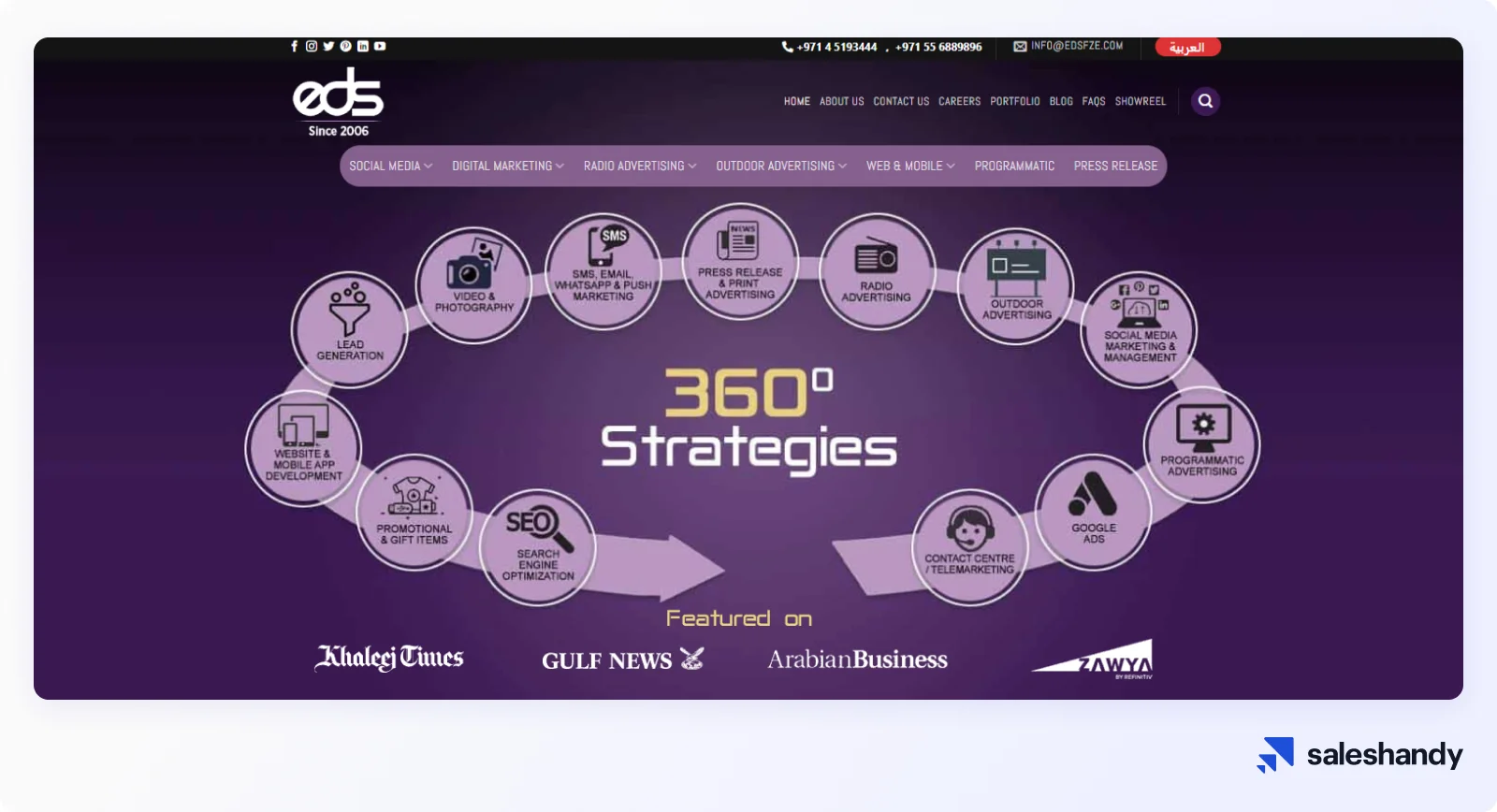
They use different marketing channels like social media, text messages, emails, and SEO to generate leads. The EDS team are experts at creating targeted campaigns that speak directly to your potential customers.
If you’re looking for a lead generation partner in the UAE that uses creative and data-driven tailored strategies, then EDS is a good option to consider.
2. Leads Dubai
Leads Dubai is a standout name for lead generation in the UAE.
Whether you own a B2B or B2C business, they can help bring in qualified leads through paid ads.
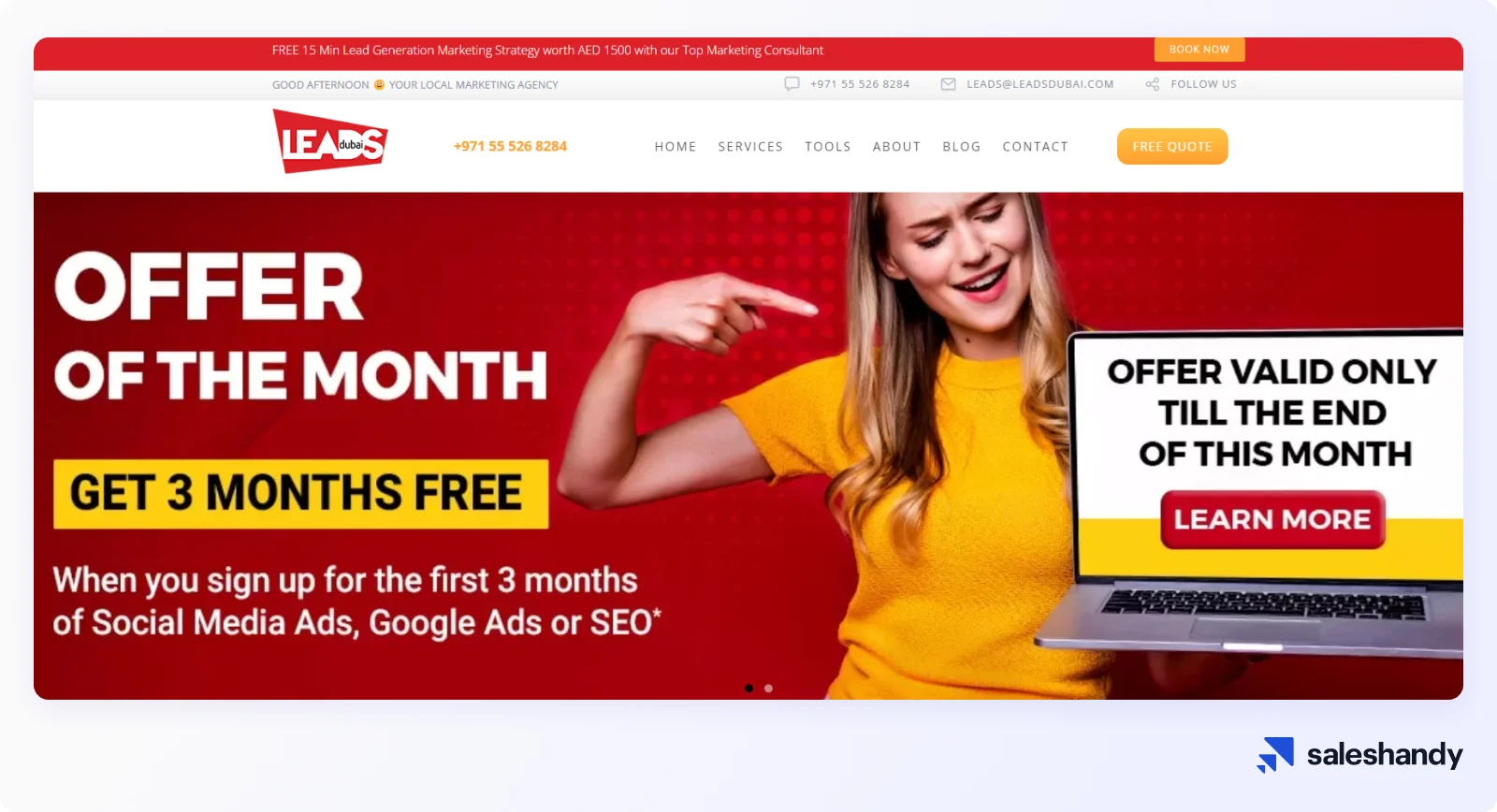
They are also experts in generating leads through SEO, SMS, WhatsApp, and email marketing.
Look at more such agencies in our 10 Best Lead Generation Companies in UAE blog.
Top Lead Generation Companies in India
1. Salesaladin
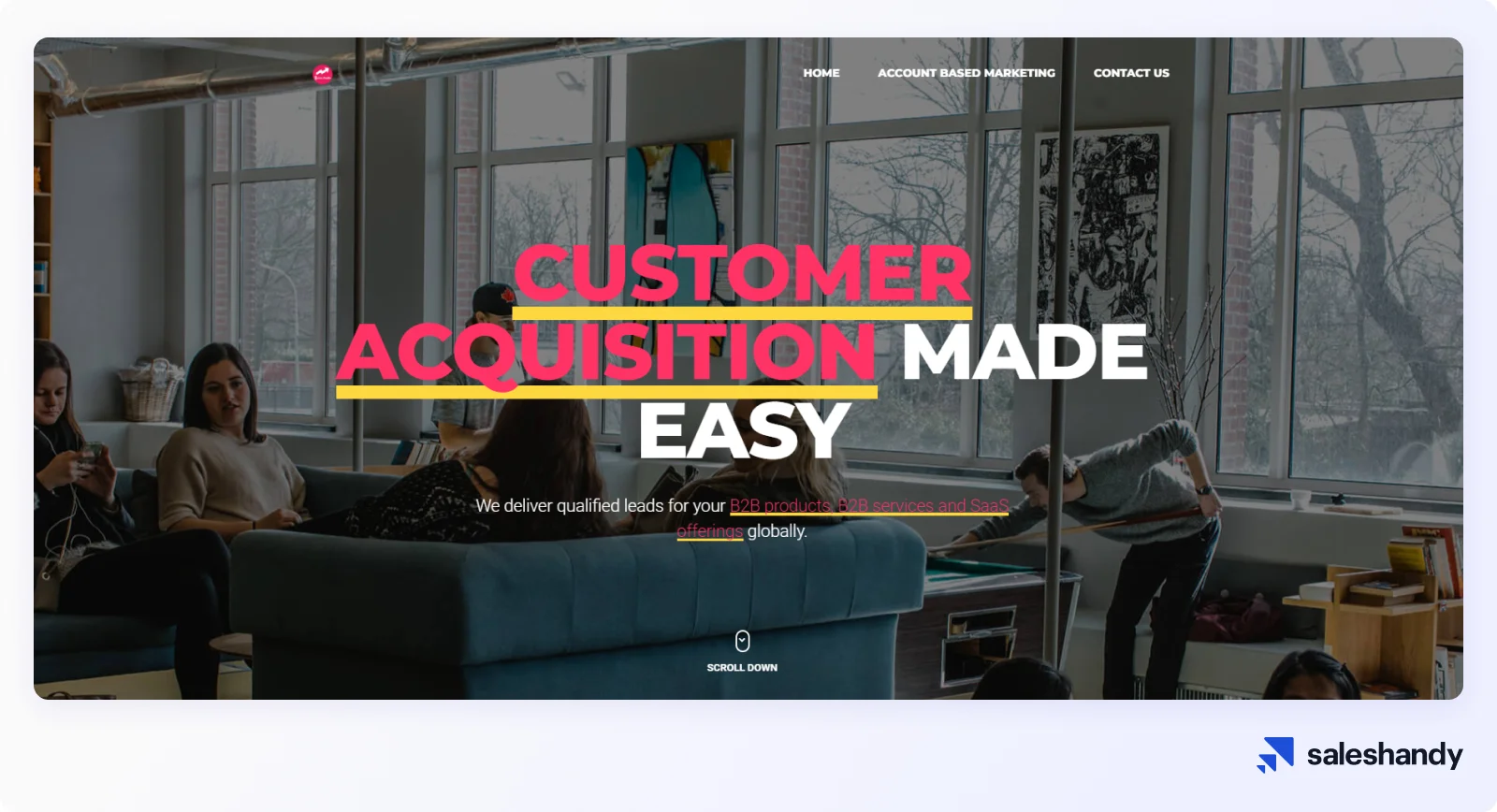
Salesaladin is a lead generation company that specializes in appointment setting and outreach campaigns for diverse clients.
They primarily work with SaaS companies and have previously worked with clients from India, Europe, North America, Latin America, and Oceania.
Their primary outreach channels include LinkedIn, emails, WhatsApp, and calls. Additionally, they help you select, customize, and manage essential marketing technology stacks, including CRMs like Salesforce and automation tools like Pardot.
2. LeadNXT
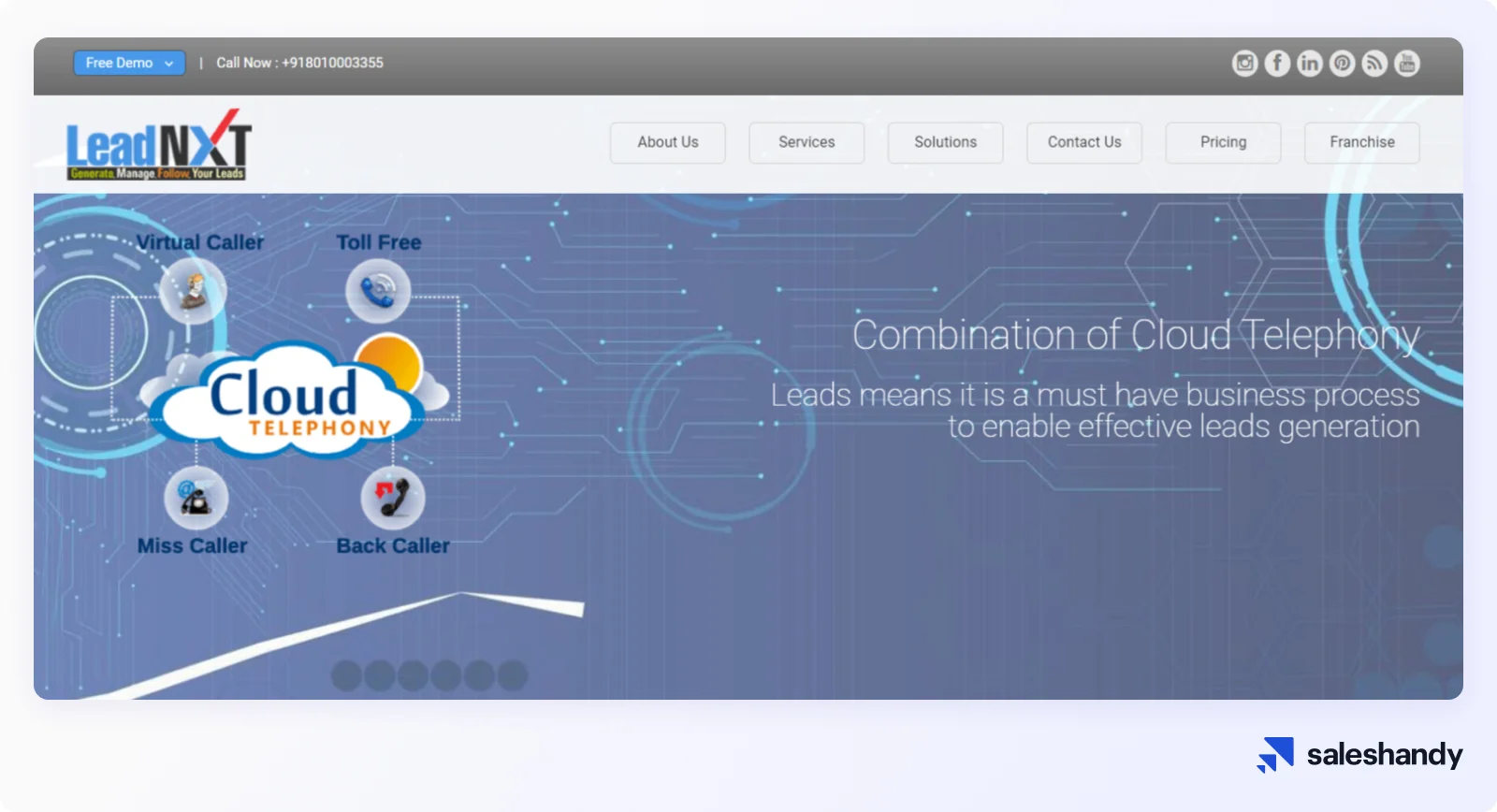
LeadNXT is another B2B lead generation company in India that can help you with lead nurturing and sales lead management services.
Their comprehensive lead services cover various sectors like finance, healthcare, insurance, etc.
If you’re looking for lead nurturing, scoring, or direct delivery of sales-ready leads, LeadNXT can be your go-to lead generation agency.
You can get a more detailed look at various other B2B and B2C lead generation agencies in our 10 Best Lead Generation Companies in India for 2024 blog.
Conclusion
This guide has provided you with the essential steps to master lead generation for your business.
It might look challenging at first, but it doesn’t have to be that hard with the right approach.
Remember, improving your lead generation strategy is a never-ending job.
Once you figure out what your audience likes and what works best, you’ll be bringing in lots of great customers.


